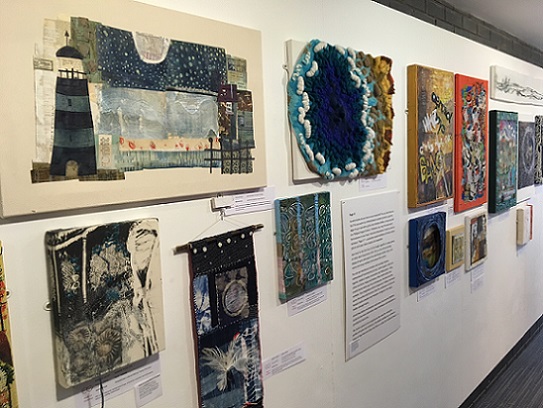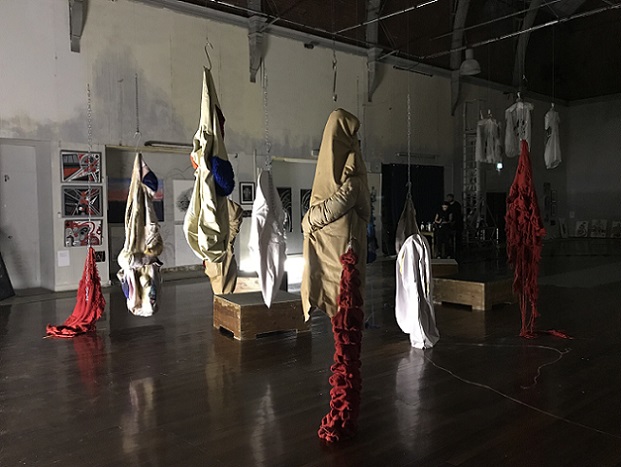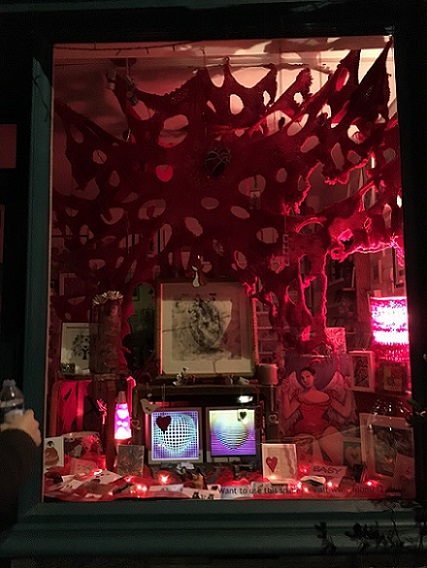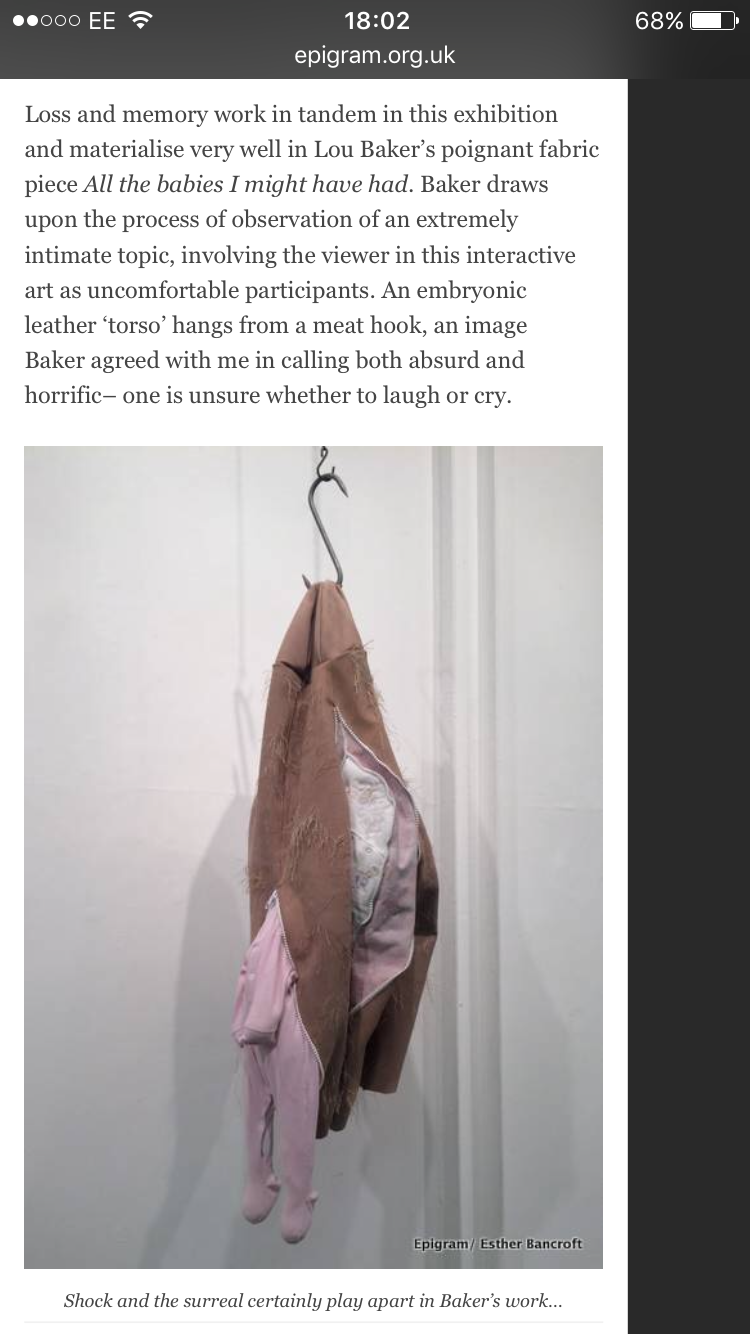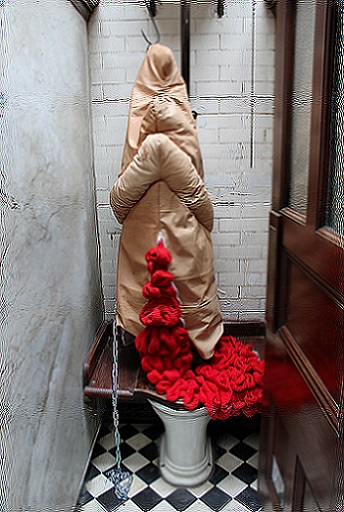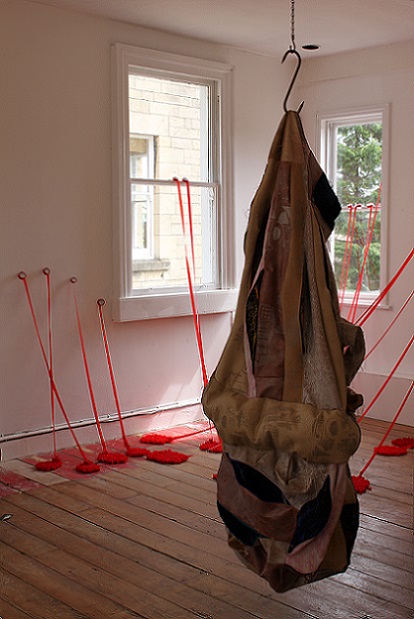Please have a look at my CV for a full list of my exhibitions.
*Scroll down for details and images of more exhibitions*
2018 and ongoing, Intent, Part 1: an online art exhibition with Cultivate Gallery, London, and Organ, curated by Sean Worrall, January 16th. For details, see below.
2017 and ongoing, Red: an online art exhibition, presented by Cultivate, curated by Sean Worrall, February 27th. For details, see below.
Past exhibitions, residencies and events
2020-2021 For my exhibitions, residencies and events during my MA please visit my MA Fine Art research website
2020 Wishing trees, 4 participatory installations situated in public spaces (Horfield Common, The Downs, Purdown and outside my house) in Bristol during the Coronavirus lock down, 24th March and ongoing
2020 Incendiary at Pound Arts, Corsham, 7th July -14th Aug. (originally set up set up in March but postponed due to Covid 19)
2020 Safety net and Living sculptures at For Art’s Sake, CMS Pioneer Conversations Day, Oxford 3rd March
2020 inaugural, an exhibition with the MA Fine Art part time cohort, Bath Spa, Sion Hill gallery, 5th -9th February
2019 International Contemporary Stitched Art exhibition with The Society for Embroidered Work, Clerkenwell Gallery, London,12th-17th Nov.
2019 B-Wing, Shepton Prison, Shepton Mallet, Somerset, part of Somerset Art Works, curated by Fiona Campbell and Luminara Star, 21st Sept -6th Oct.
For images and details of this ambitious site responsive exhibition, please visit the B-Wing website. For my installations at B-Wing see my Artist page.
2019 Living sculptures, a participatory installation, at the Wool Day Conference at Bicton College, Devon, June 15th
2019 Plastic activism, a participatory installation, at Bicton College, Devon, June 11th- June 26th
2019 RWA Sculpture Open, RWA, Bristol 16th March - 2nd June
Hanging out with Pillar of fire I at the PV of the RWA Sculpture Open exhibition, 15th March
I am so delighted that my hand knitted soft sculpture, Pillar of fire I, has been selected for the RWA Sculpture Open exhibition! It's certainly the only knitted sculpture and the only constructed textile piece in the show. Apparently there were 1100 submissions and just 88 selected and mine is one of them!
I had given two options for installing it - either on a stand or hanging from a hook on the wall. I gather they had far fewer wall based sculptures so chose the hook option. It looks great, and I like the fact that it's so adaptable and site responsive.
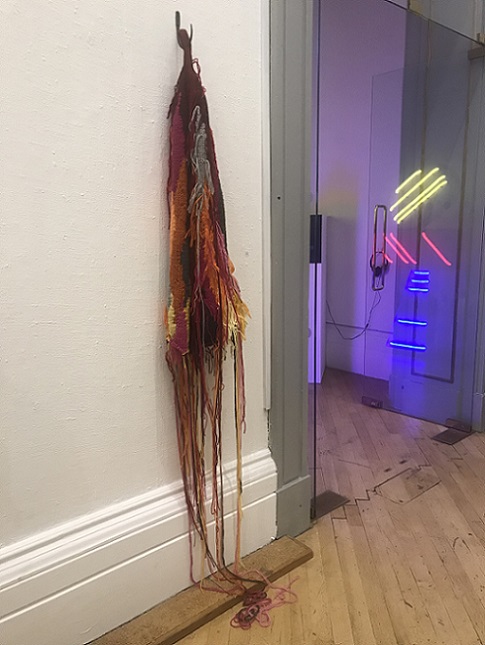
Pillar of fire I, alongside the reflections of Stuart Robinson's neon sculpture, He said the sun came out, he said it spoke to him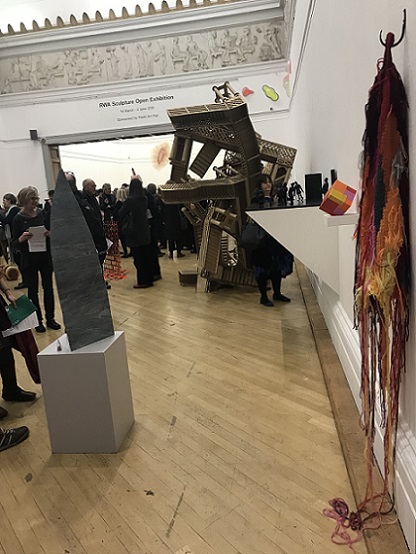
The private view 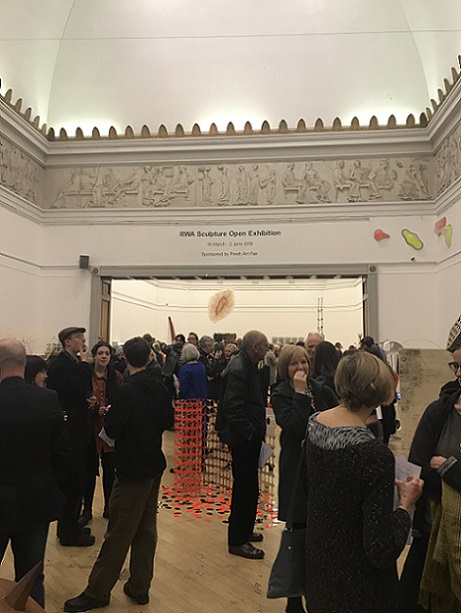
It was buzzing!
All work is for sale on the RWA website.
Pillar of fire I is part of a series in progress. Have a look at the 4 Pillars of fire installed together. Who knows how many there will eventually be?
2019 Incendiary: set on fire - 'Waste’ at Stroud Valleys Artspace (SVA), Stroud, curated by Patricia Brien, 6th - 10th Feb
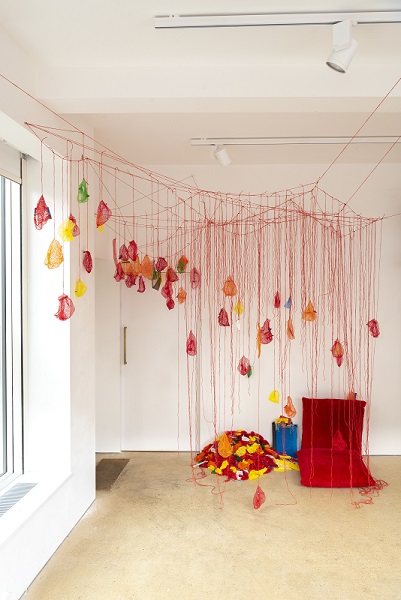
My participatory installation, Tethering our thoughts, string, fruit nets, labels, at Incendiary exhibition (SVA), Day 1. (Image: Mike Garlick)
For more details about this work, see my Participatory art and social engagement page and click on the image below for my documentation of the process, responses and reflections.
Have a look at a walk-though of Incendiary exhibition on Day 2.
‘Incendiary is a multi-site exhibition consisting of 23 artists and the Walking the Land Artists collective responding to the firing of industrial-incinerators & combustion fallout on human & more than human ecosystems. It is exhibiting in Stroud at SVA and Lansdown Gallery, as well as the University of Gloucestershire’s Hardwick Campus, Cheltenham.
The initial idea came from a conversation between a direct action protestor Dr. Gail Bradbrook and the curator, Patricia Brien. It was a discussion around the persistence of industrial incinerators like the recent development of the Javelin Park Incinerator, despite much public protest and debate.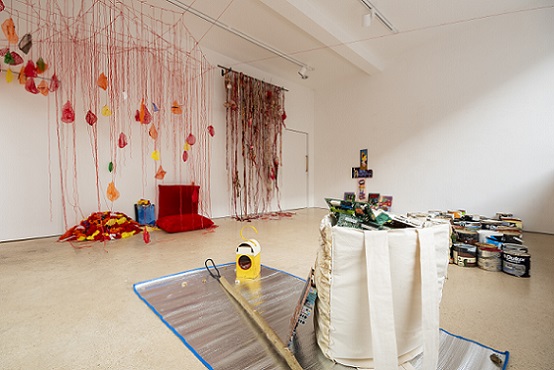
General view of Incendiary at SVA. Clockwise from left, Lou Baker, Tethering our thoughts, Fiona Campbell, Glut, Angela Baum, Floored, Nicola Grellier, Paint tin, Mair Hughes, Ragpicking (Image: Mike Garlick)
The participating artists have responded to different facets associated with the inferno-incinerator theme. The themes that have been drawn out the works are Waste, Breathe, Fire, Carbonise, Toxic Grief, and Biophilia. Many artists have responded to the increasing levels of pollution and toxic waste that are suffocating our cities and towns. At a closer physical proximity are the everyday combustion engines; cars, buses, trucks, boats, planes that expel airborne particulate matter via our roads, waterways, and skyways. One artist is focused on nuclear toxicity, where the notion of ‘persistence’ has an entirely different timescale.
The inferno-incinerator conjures the destructive power of elemental fire & borrows from a powerful fire / regeneration association found in various mythologies. Several artists responded to this eternal fascination with fire. Images of Dante’s burning Inferno spring to mind as hyper consumption and subsequent waste fuels the fire and transforms it into toxic matter.
Incendiary is a statement about the urgency required to change our ‘combustion’ narratives as things noticeably heat up. Artists participating in the Incendiary exhibition come from as far as Australia, with several London-based artists in the mix as well as practitioners coming from Bath, Somerset, Bristol, South Wales, and the Stroud Valleys.
The artists are exhibiting a variety of media including installation, photography, textile, ceramics, sculpture, painting and illustration.
Patricia Brien, the curator says of the exhibition:
“Curating artistic responses to ecocide requires working between the energetic direct action of protest and a slower, reflective practice. Art protest is ages old, and Incendiary is part of that tradition. Humans communicate their inner thoughts and opinions in different ways and it is vital to strive for new positive narratives for the future even in the face of environmental crisis.”
Artists at SVA: Mair Hughes, Fiona Campbell, Nicola Grellier, Angela Baum, Lou Baker
Images of Incendiary:
1. Incendiary poster
2. Incendiary events
3 -12. Incendiary exhibition at SVA (Images: Mike Garlick)
The other parts of the exhibition took place at Lansdown Gallery, Stroud, 4th -10th Feb. and Hardwick Gallery, University of Gloucestershire, Cheltenham, 4th - 17th Feb.
Artists at the other sites: Alison Harper, Lydia Halcrow, Sabine Kussmaul, Kaori Homma, Joanna Wright, Annelies Egli, Ryan Orme, Rod Gray, Liz Blum, Nikki Alford, Walking the Land artists, Alice Sheppard Fidler, Nicholas Cheeseman, Simon Ross, Jezella Pigott, Lisa Porch, Karen van Kalmthout, Maria Jose Carvallo, Christopher Bowers
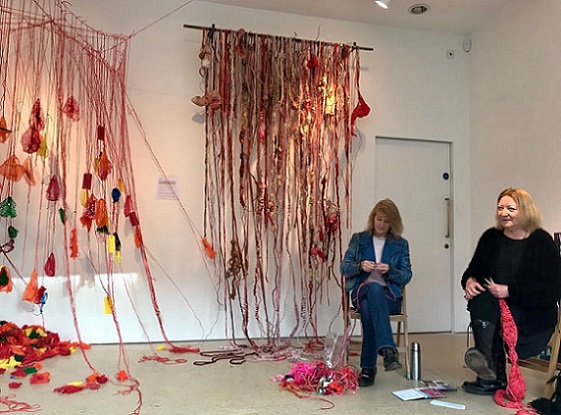
Saturday 9th February, 11 - 12, 'Join in the conversation', a performative conversation with Lou Baker and Fiona Campbell, where we discussed our practices.
'Join in the conversation' flyer

Knitted plastic bags - knitted during the conversation!
The conversation continues....
2018
2018 Page 17 with The Embroiderers' Guild at Artrix, Bromsgrove, Sept.5th - Nov. 4th, curated by Amanda Smith and Alex Messenger, part of a touring show (see below)
My piece, The sea, the sea, felted hand knitting, centre, installed at Page 17 at Artrix, Bromsgrove. This is the last leg of a year-long tour organised by The Embroiderers' Guild. See below for more details.
2018 disquiet at Walcot Chapel, Bath with Clare Thatcher, September 18th -23rd
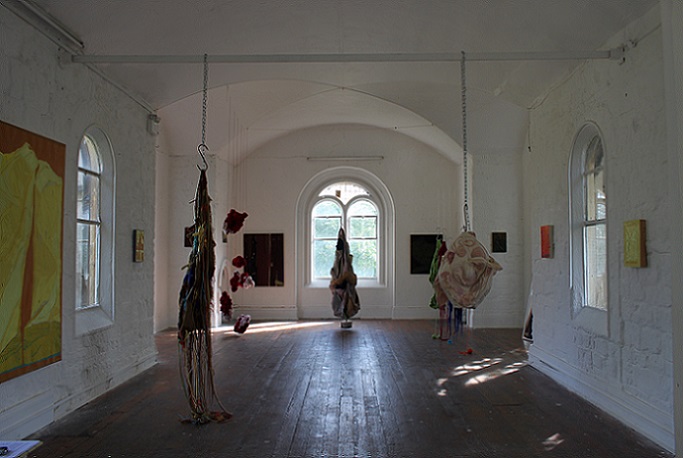
The view of the exhibition from the door.
'disquiet [dis-kwahy-it] noun: lack of calm, peace, or ease; anxiety; uneasiness
disquiet is an exhibition of paintings and sculptures by Clare Thatcher and Lou Baker, who are showing together for the first time at Walcot Chapel in Bath. Although they use very different materials and processes they recognise similarities in their work and, for this exhibition, they have made some new pieces in response to one another’s work.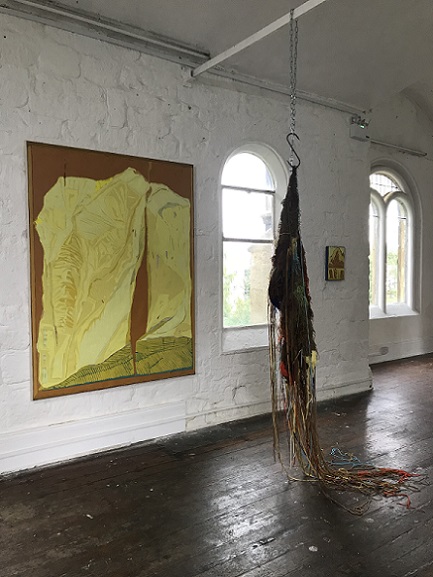
My knitted soft sculpture Internal monologue hanging in front of one of Clare's paintings
At first glance, the two artists’ work seems utterly dissimilar; Clare works with oil and pigments, creating two dimensional paintings, whereas Lou uses knitting and stitch to make body-like sculptural forms. On closer inspection, however, affinities between their works become evident. 
6 of my hand knitted, felted Parts of me, suspended in the gallery
Colour is important to both artists, but each uses it quite uniquely. Clare paints layers of hand-mixed pigments of pure colour, adding a particular quality to the final piece. Lou, on the other hand, selects specific colours to communicate meaning and provoke a range of conflicting responses, from discomfort to pure delight. Despite these markedly different approaches, there are curious visual resonances in the colour combinations they choose. Somewhat surprisingly, possibly, as they are working in such very different mediums, surface is an important connection too. The presence of the pigment in Clare’s paintings, plus the layering of paint, creates interesting and sometimes unexpected surfaces which create pleasing contrasts to certain features of Lou’s highly tactile soft sculptures.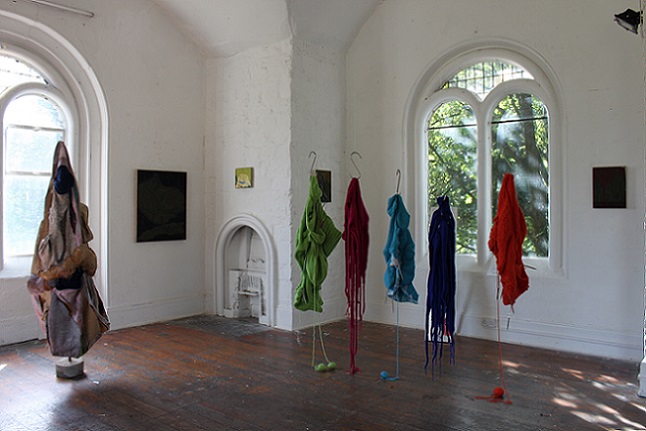
Nobody 1 with my 5 knitted Living sculptures
The concepts behind each artist’s work are very distinctive. Clare’s paintings are deeply connected to place and Lou’s to identity but there is an undercurrent in each artist’s work which explores common facets of the human psyche. This is visualised through elements of hiddenness in each artist’s work; in the zips, drapes and folds of Lou’s soft sculptures and in the glimpses of the history of Clare’s layered painting. In terms of process, they have other aspects in common as well. Both find that the repetitive nature of their work helps them to quickly enter a meditative timelessness, the state of flow, which is linked to creativity, and ultimately to happiness. There is also alchemy in some of the processes they use. Clare’s use of pigment involves the skilled mixing of pure colour with cold pressed linseed oil. As the paint dries the colour and surface can change unpredictably. Lou spends many weeks painstakingly knitting a form which she then subjects to the relatively quick, unpredictable felting process. Although they’re such different processes this alchemy brings about a disquieting change in control.
Detail of The whole is greater than the sum of the parts
For this exhibition they have responded to and been influenced by one another’s work so that there are numerous echoes between the forms that each artist presents. It is as if Clare’s paintings are embodied by Lou’s sculptures, and the spatial qualities of Lou’s hanging forms are reflected in Clare’s paintings.'
Have a look at a video of a walk-through disquiet exhibition.
It was wonderful to have the opportunity to try out my Living sculptures participatory installation during the disquiet exhibition. It felt like a privilege to witness the different ways that visitors engaged with it. Have a look at the full documentation of Living sculptures,, by clicking on the image below. It includes the research behind the work, lots of delightful images, responses from the public and my own reflections.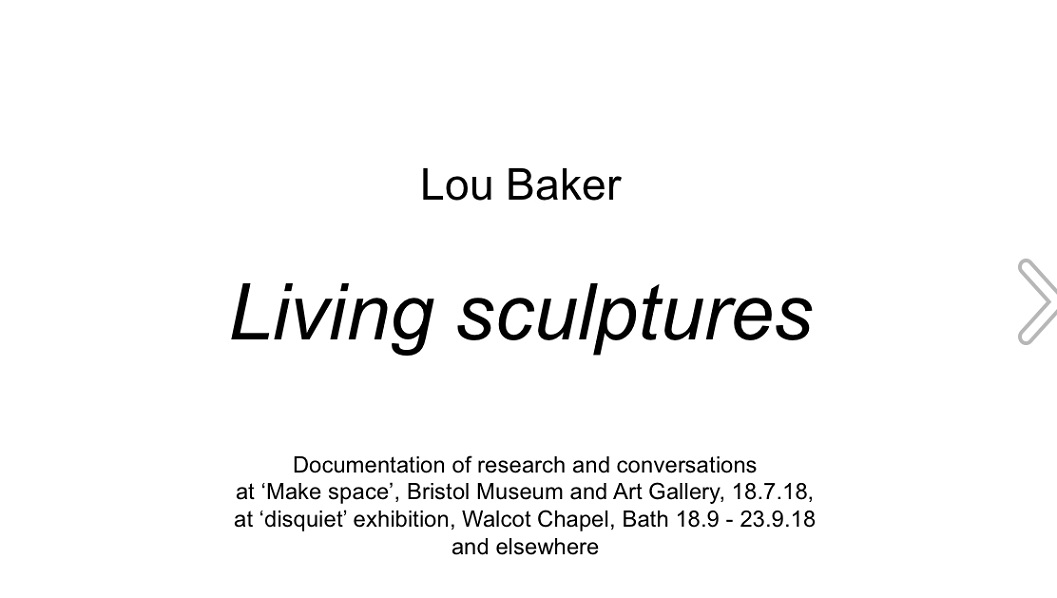
Have a look at these videos as well. I especially love the way that wearing my Living sculptures seems to make people move differently!
1. Living sculptures, knitted series
2. Living sculptures, trying them on
3. Living sculptures, green
4. Living sculptures, together
5. Living sculptures, twirling
6. Living sculptures, friends
7. Living sculptures, dancing
There are also more details about it on my Participatory art and social engagement page. I'm hoping to extend this idea further, so watch this space!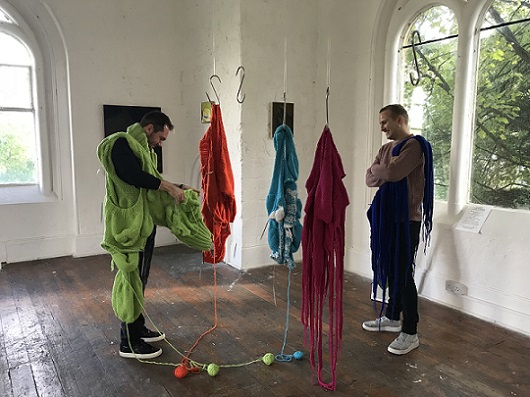
Several visitors becoming Living sculptures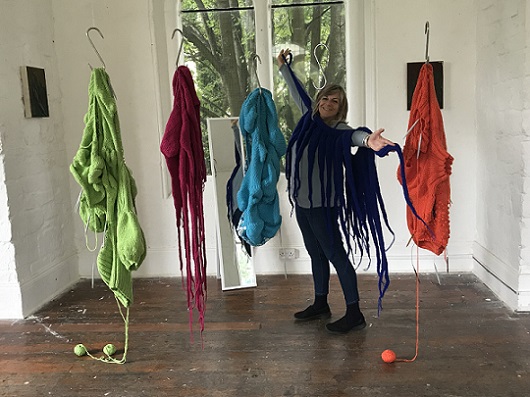
During the exhibition, I also made a site responsive installation outside the chapel in the porch using red monofilament. I loved making it. It was like drawing in space. The chapel is a listed building so I couldn't make new holes which meant that I had to use the holes that were there, so there were limits to what I could do. I really enjoyed seeing what was possible within these parameters. The installation was a transformation. It was almost invisible, sparkling, magical. I'd like to do something similar in a much larger space.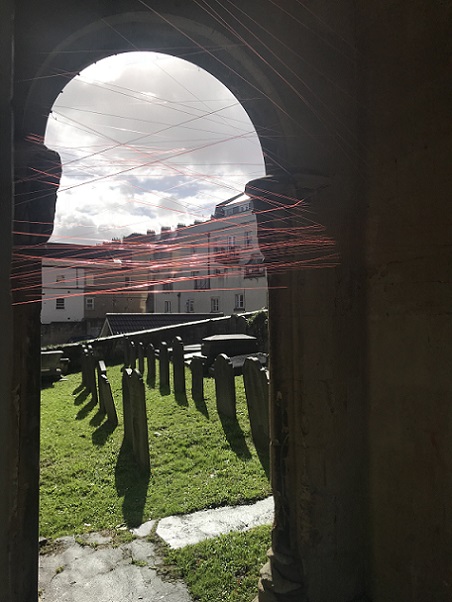
Have a look at some more images of disquiet:
1. disquiet poster
2. One of my Living sculptures in front of one of Clare’s paintings
3 - 6. Walking into disquiet at Walcot Chapel, flanked by my knitted diptych, Heart of darkness
7. View of disquiet from the door
8, 9. Internal monologue, 2018, in front of one of Clare’s paintings
10. View of part of disquiet
11. Inspecting Internal monologue
12. Detail of Internal monologue
13 - 16. Parts of me, 2018, felted hand knitting, series of 6
17. One Part of me
18. Parts of me with Nobody I, 2015
19, 20. Nobody I
21. Nobody I with Living sculptures, 2018
22 - 25. Living sculptures
26, 27. Visitors trying on my Living sculptures (Have a look at the documentation of Living sculptures)
28, 29, 31, 35. The whole is greater than the sum of the parts, 2018
30. The whole is greater than the sum of the parts, detail
32, 33, 34. More views of disquiet
36, 37. Heart of darkness
38 - 40. Red monofilament installation
41, 42. Visitors
43, 44. Camouflage!
2018 Living Sculptures, a participatory event at Make Space, alongside the Woman's Hour Craft Prize exhibition at Bristol Museum and Art Gallery, July 18th
The Make space at Bristol Museum was a programme of day-long exhibitions, events and workshops which ran for the duration of 'The Woman’s Hour Craft’s Prize' from 7th July -2nd September 2018. Local artists and makers were invited to submit proposals and my Living sculptures proposal was accepted to run on the 18th July, from 10-4. 
My new hand knitted Living sculptures
Living sculptures is an interactive, participatory installation of wearable, hand knitted and stitched soft sculptures. Normally, in an art gallery, there are signs saying ‘Do not touch’; what happens if the viewer is not only encouraged to touch but is invited to become a living sculpture by wearing an abstract soft sculpture? What would it look like? How would it feel?

How to become a Living sculpture
I invited my visitors to become living sculptures by wearing a soft sculpture, or several! I had made 6 new oversized garment-like sculptures- 5 knitted ones in vivid colours and one furry, white stitched sculpture. I also included several of my original soft sculptures which can also be easily worn. I had fun working out ways to install them so that they were readily accessible!
Here's a walk-through video of The Make space during my Living sculptures day and a second walk through later in the day.
One visitor wearing The whole is greater than the sum of the parts, 2018
The room itself was adjacent to the main exhibition and only accessible to paying visitors, but there was a re-entry policy whereby one could return as many times as required with that ticket. The room itself was more like a making space than a gallery, and included some beautifully hand crafted furniture etc. It meant, however, that it was quite hard to find a blank wall to take photos! I set up a photo background but decided it wasn't big enough so dismantled it and, in the end, took photos of my participants amongst the other sculptures. 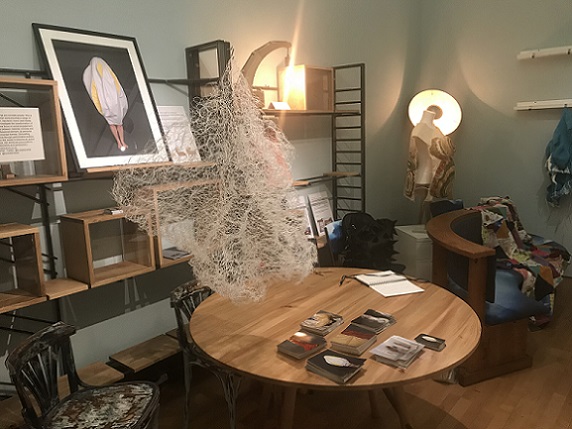
The Make Space set up with my Living sculptures, 18.7.18
Identity is often communicated through the clothes we wear, but, at a deeper level, the multiple selves we reveal to the world can conceal our true sense of self. Living sculptures investigates this disconnect. Giving visitors the opportunity to wear bizarre, abstract soft sculptures, with this in mind, will hopefully lead to reflections on balancing these multi selves… as well as some hilarity, hopefully!
And here are some videos of my Living sculptures in action:
1. Rocking
2. Dancing
3. Spinning
4. More dancing
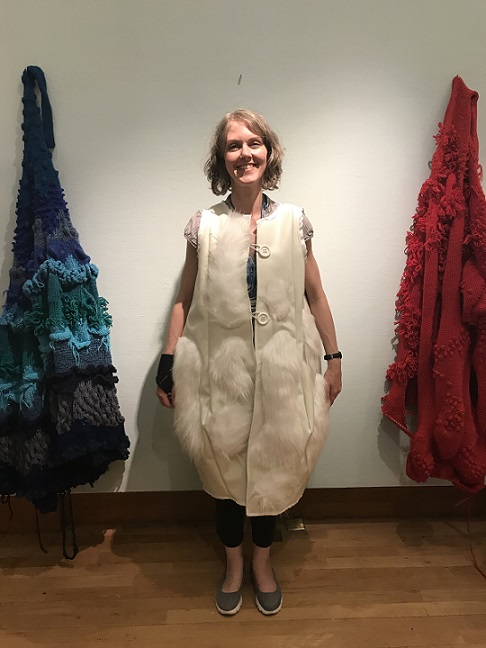
One visitor wearing my new stitched furry Living sculpture, flanked by Nobody 3 (left) and Heart of darkness I (right)
I documented the event with photos, videos and interactive feedback. It was wonderful! I especially loved the conversations I had and the fabulous ways that people moved when they were wearing my work! According to the feedback, the participants found it playful yet also thought provoking. Many thanks to all my participants!
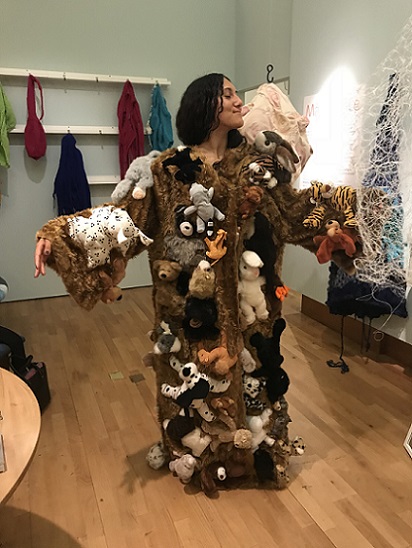
One visitor feeling very regal, wearing, No animals have been harmed in the making of this garment, 2011
I have subsequently trialed Living sculptures for a week at disquiet exhibition at Walcot Chapel in Bath in Sept 2018 (see above) and have fully documented the research from both events here, or please click on the image below.
There are also more details about the project on my Participatory art and social engagement page, about the knitted Living sculptures on my Knitting page and the furry stitched one my Stitch page!
I hope to extend these ideas further by installing a roomful of wearable soft sculptures at some point in the future, so watch this space!
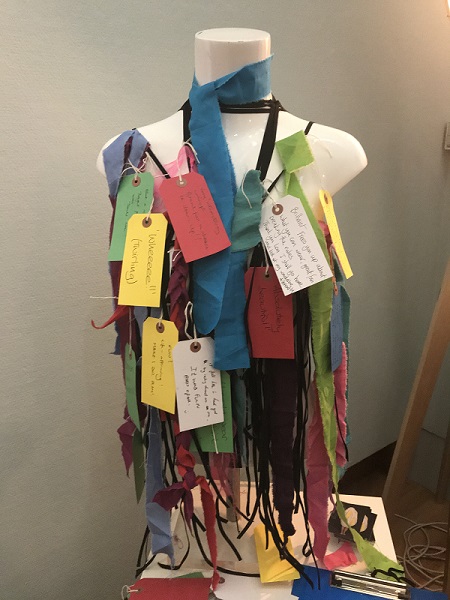
Although I was there all day, engaging with my visitors, I also wanted a way to gather written feedback so I used this mannequin and provided labels, pens and clipboards.

Just one of the great responses to Living sculptures!
Here's a gallery of images from Make space:
1. Introducing The Make Space at Bristol Museum and Art Gallery
2. Living sculptures instructions
3. My new furry Living sculpture, 2018, imitation leather, fake fur, buttons; stitch
4. My new knitted Living sculptures, 2018, hand knitted wool
5- 10. Living sculptures at make Space, 18.7.18
11, 13, 20. Living sculpture, blue
12. Living sculpture, pink
13. Living sculpture, green
14. Living sculpture, furry and Heart of darkness I, 2017, hand knitted wool
16, 25. Living sculpture, furry
17. Social network I, hand knitted monofilament
18. Living sculpture, turquoise
19, 22. No animals have been harmed in the making of this garment, 2011, fake fur, cuddly toys
23. Nobody 3, 2014, hand knitted wool
20, 26. Heart of darkness II, 2017, hand knitted wool
2018 Subversive surfaces; taboo and fragility in the art of Gina Baum and Lou Baker at Trowbridge Town Hall Arts, Trowbridge with Gina Baum, curated by Katie Ackrill, June 9th - July 14th
(Excerpts from the Subversive surfaces exhibition guide written by Katie Ackrill, curator.)
'Subversive Surfaces: Introduction
This exhibition challenges modern perceptions of the human body through the thought-provoking work of Gina Baum and Lou Baker. Through their practices they work to break down the many boundaries constructed in our collective consciousness; those divisions between private and public, interior and exterior, which shape our attitudes toward the body as an uncomfortable site of taboo and fragility.
The corporeal surfaces they create invite us to feel them with our eyes. Sometimes they are appealing, other times repellent, and often both; creating a push and pull between the beautiful and the grotesque, amusement and horror, attraction and repulsion. They provoke a response, encouraging us to acknowledge issues that are difficult to talk about; and the physical, psychological and emotional vulnerability that accompany them.
The term subversive also refers to the way the artists work. Using ceramics and textiles they create challenging sculptural works which undermine the expectations of these materials, questioning a long-standing division between art and craft. Exquisite porcelain forms and soft sculptures take what are normally considered traditional craft materials into the realm conceptual art.
Subversive Surfaces takes place in the Main Gallery, Basement Cells, foyer and stairwell of Town Hall Arts.
Subversive surfaces: Main Gallery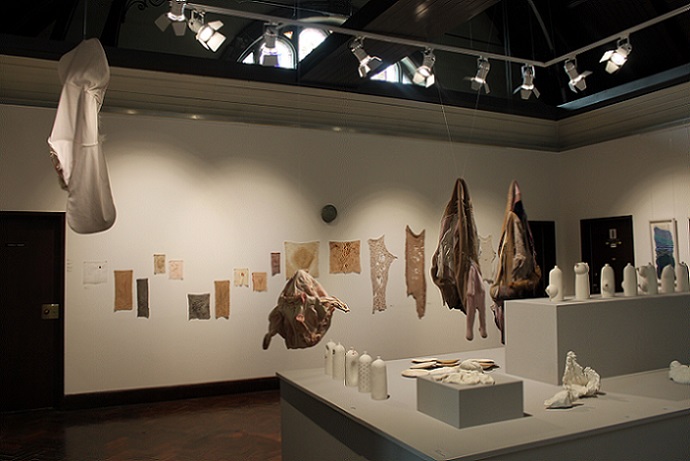
General view of Subversive surfaces in the Main Gallery
In the Main Gallery, we encounter work exploring themes of healthcare and motherhood. Lou Baker’s uncanny hanging sculptures incorporate hair, baby grows, discarded clothes, zips, fake fur, imitation leather and velvet. In their clear nod to bodily form we are reminded of the fragile divide between the interior and exterior, both physically and psychologically. 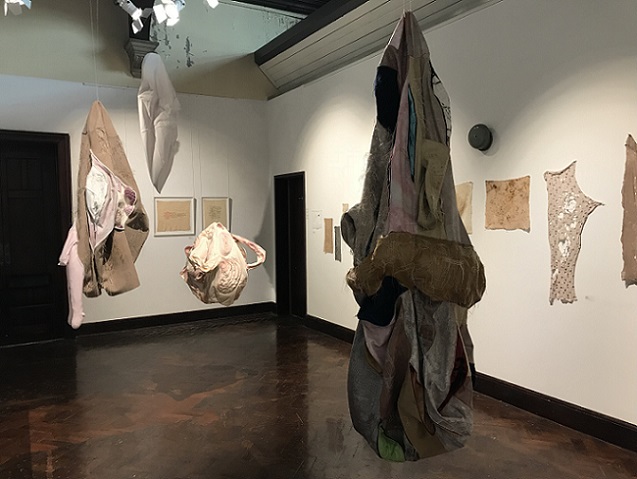
Lou Baker's hanging soft sculptures with Gina Baum's stitched work
Gina Baum’s intricate stitched wounds and exquisite porcelain forms explore attitudes toward healthcare and the imperfections of the body. Her previous profession as a nurse informs much of this practice, which frequently incorporates muslin and gauze, and confronts the viewer with nauseating wounds and familiar bodily surfaces. Through the centre of the plinth, Baum’s Indignity Bottles consider the implications of old age as dependence on others increases. 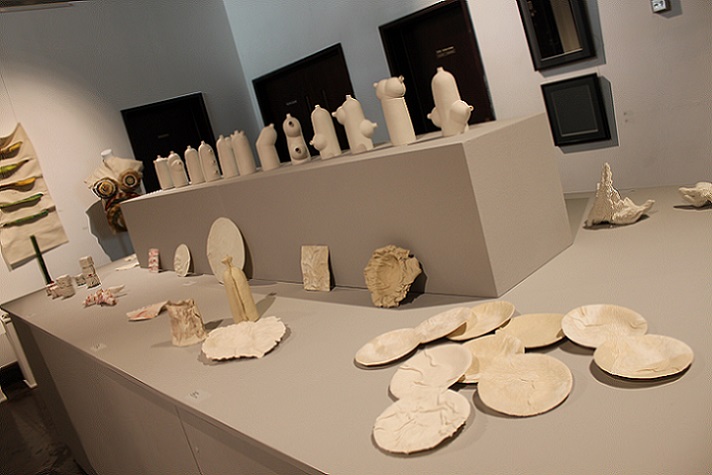
Gina Baum's porcelain sculptures
Also in the Main Gallery, the artists use stitch and porcelain to explore body image and the body’s connection to the natural landscape. Baker’s Body Image I and Body Image II give viewers the opportunity to consider their relationship with their own body, and their body’s relationship with its surroundings.
Lou Baker's Body Image I reflecting part of the exhibition
Have a look at a video of one visitor's delightful interaction with my soft sculpture,The whole is greater than the sum of the parts!
Here are some more images of the Main Gallery:
1-9. General views of the Main Gallery
10 -14. Gina Baum, stitched wounds and clothing
15 -17. Back wall, with Lou Baker, knitted Seascape I, II and III, and 2 stitched pieces, Over the hills and far away and The parts I’d like to remove alongside some of Gina’s ceramic sculptures
18, 19. Lou Baker, Body image I, Body image II and Pharmacopoeia
20. A selection of Gina Baum’s ceramic and glass works
21 -23. Lou Baker, hanging soft sculpture, Other I
24 -28. Lou Baker, stitched soft sculpture, The whole is greater than the sum of the parts
27. Lou Baker, The whole is greater than the sum of the parts becomes a living sculpture!
29. Lou Baker, All the babies I might have had II
30, 31. Lou Baker, Nobody I
32, 33. Reflections in Lou Baker’s Body image I
34. View across the gallery
35, 36. Lou Baker, Pharmacopoeia, stapled pill packets
37-41. Photos from the opening event on 9th June
Subversive surfaces: Foyer and Stairwell
'In the most public of Town Hall Arts’ spaces the artists show work exploring some of the most private of subject matters. Lou Baker’s All the babies I might have had hangs majestically over the stairwell; a confessional womblike web of anxiety. Outside the Main Gallery, Gina Baum’s Tools of my trade, a series of hand cast and hand painted porcelain speculums, hangs in a formerly vacant display cabinet.
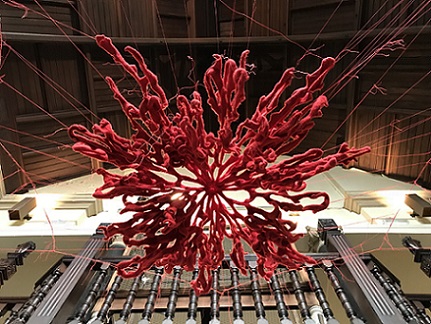
Lou Baker's All the babies I might have had I, felted hand knitting
Surprising works by the artists can also be found in the entrance foyer; including delicate gauze-inspired drawings by Baum. This space will be further transformed after visitors are given the opportunity to make their own “subversive surfaces” on 30 June 2018.'
Here are some more images from the foyer and stairwell:
1-3. Gina Baum,
4. Lou Baker, Other 3
5-14. Lou Baker, All the babies I might have had I, felted hand knitting
15. Gina Baum, drawings, Lou Baker, photographs
16. Gina Baum, drawings
17. Lou Baker, Wearing the unwearable series, photographs of the artist wearing two of her soft sculptures, Other 3 and Nobody 3
18. Lou Baker, Wearing the unwearable series, photographs of the artist wearing one of her soft sculptures, Other 3
19. Lou Baker, Wearing the unwearable series, photographs of the artist wearing one of her soft sculptures, Nobody 3
Subversive surfaces: Cells
'In the Basement Cells we are confronted with a darker, more unsettling series of installations, with clearer allusions to the fragile boundary between the interior and exterior body. Sometimes these are darkly humorous, and at other times extremely uncomfortable to encounter.
Subversive surfaces, general view of the main cells
Difficult issues are raised, as seen in Baum’s FGM, which juxtaposes beautiful stitch work and the horrific subject of Female Genital Mutilation. Baum also looks at scarring through works including Cicatrix and Contagion; the latter comprising of forty-one delicately rendered wounds, spreading like a rash throughout the end interrogation room.
Baker presents the sinister, alien-like forms of her Other series, which are characterised by fleshy material and bright red innards. Her most recent work, Parts of Me, explores the physical and psychological divide between the public and private through soft felted sculptures, which are at once tangible and uncannily organ-like.

Lou Baker, Other 5, leather, hand knitting, zip
In the Victorian Cells, which are quietly hidden away to the left of the basement’s entrance, the artists transform the spaces in small yet impactful ways; adding to the eclectic selection of objects and artefacts already stored there.
Basement Cells: Interactive Installations
Having encountered this collection of beautiful yet unnerving artworks, the viewer is encouraged to reflect on what makes them comfortable and uncomfortable, in a participatory installation named comfort/discomfort, which will be added to and transformed throughout the exhibition.
An additional interactive element can be found in the interrogation room adjoining the comfort/discomfort installation. The work in this space gives visitors the opportunity to feel the surfaces created by Baum and Baker.'
(Excerpts from the Subversive surfaces exhibition guide written by Katie Ackrill, curator.)
comfort/discomfort opened when the exhibition opened, on 9.6.18. Have a look at a walk in video of comfort/discomfort taken on 13.6.18 and then see how it changed over time by looking at a video of the installation taken on 14.7.18.
And here are some more images from the cells:
1 - 5. Lou Baker, Social network, a diptych of knitted monofilament
6. Gina Baum, FGM
7 - 9. Lou Baker, Other 5, Gina Baum, porcelain skin
10. General view of entrance to main cells, ceramics, Gina Baum, knitted soft sculpture, Lou Baker
11. Lou Baker, Nobody 3
12. General view of main cells, porcelain skin & Bertha, Gina Baum, Parts of me, a series of 6 felted soft sculptures, Lou Baker
13. Gina Baum, Bertha
14. Gina Baum
15 - 22. Lou Baker, Parts of me, a series of 6 hand knitted and felted soft sculptures
23 - 25. Gina Baum, ceramics
26. General view of the ‘Touchy feely’ room, featuring, l-r. Gina Baum, ceramics and stitched piece, Lou Baker, The parts I’d like to remove, cloth sketchbook, and Heart of darkness I, hand knitted soft sculpture
27. Lou Baker, Heart of darkness I, hand knitted soft sculpture
28, 29. Gina Baum, Infective, ceramics and stitch
30. General view of the ‘Touchy feely’ room, featuring, l-r. Lou Baker, All the babies I might have had I, cloth sketchbook, the doorway into comfort/discomfort interactive installation, Gina Baum, ceramics and Lou Baker, Heart of darkness I, hand knitted soft sculpture
31 -35. Lou Baker, cloth sketchbooks, All the babies I might have had I and The parts I’d like to remove
36 - 40. Lou Baker and Gina Baum, comfort/discomfort, an interactive installation, 13.6.18
41. Visitors interacting with comfort/discomfort, 5.7.18
42. comfort/discomfort, 10.7.18
43 – 45. comfort/discomfort, 14.7.18
46, 47. Lou Baker, Other 4
48. Gina Baum, ceramics
49, 50. Lou Baker, My imaginary friend, used clothing, zips; stitch
51. Gina Baum, ceramics
52. l-r. Katie Ackrill, curator, Lou Baker and Gina Baum with Lou Baker’s Parts of me
2018 Page 17 with The Embroiderers' Guild at Harborough Museum, Market Harborough, Leicestershire, curated by Amanda Smith and Alex Messenger, 26th March - 2nd June, part of a touring show, see below.
2018 Page 17 with The Embroiderers' Guild at The Fashion and Embroidery Show, NEC Birmingham, March 15th - 18th, part of a touring show (see below)
I’m delighted that I finally got to see my hand knitted, felted piece, The sea, the sea, in situ at Page 17 at The Fashion and Embroidery Show, NEC Birmingham. The exhibition is the result of a call out by The Embroiderers’ Guild for textile art inspired by a book and, as a former Embroiderers’ Guild Scholar, I was invited to submit a piece. It’s a touring exhibition and this is its third iteration. It was on show at The Knitting and Stitching Shows in London and Harrogate in September and October 2017 but sadly I was unable to get to either event. Finally I was able to see it in Birmingham! After this it’s due to be installed at Harborough Museum in Market Harborough from 3rd April to 2nd June 2018 and then at Artrix, Bromsgrove in October 2018.
My felted, handknitted piece, The sea, the sea,
exhibited as part of the Page 17 exhibition
at The Fashion and Embroidery Show, NEC Birmingham
There are over 100 pieces of textile art in the exhibition, showcasing a delightfully diverse selection of stitch techniques and processes. I love the fact that there’s clearly a real mix of experience and skill too. Many established artists, whose names I recognise, are exhibited alongside artists I’ve never heard of. A truly inclusive show! I feel privileged to be a part of it. I’m also very pleased to have seen the full exhibition. It was curated sensitively, by colour, and in an interesting way as a form of salon hang and I enjoyed seeing the interactions between different pieces. I especially loved seeing how my piece was influenced by those around it. I came away inspired to use more hand and machine stitch as mark making in my work again!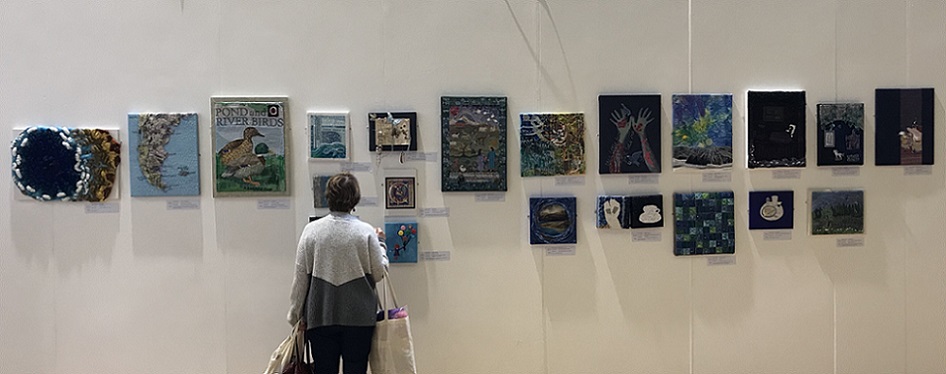
 The outer, 'blue wall' of the Page 17 exhibition at The Fashion and Embroidery Show,
The outer, 'blue wall' of the Page 17 exhibition at The Fashion and Embroidery Show,
including The sea, the sea
It interests me, though, as I think my work is the only piece which doesn’t use embroidery of some sort. It’s not surprising really, I suppose, in an exhibition organised by The Embroiderers’ Guild! I chose to knit my submission because the time I had to make it was over the summer, whilst we were away on holiday, so it was perfect. For me, knitting is a big part of relaxation, a stream of consciousness, it’s like breathing, as I have described on my Knitting page and my Blog. It’s very portable so I knit whenever and wherever I can; by the pool, on the beach, in the pub, in the car. It would help me to knit when I fly as well, of course, as I find it very calming and time passes quickly, but sadly knitting's still not allowed on many airlines. I did, of course, check with the curators that knitted work would be acceptable before I started …. For further images, information and reflections about The sea, the sea, which is inspired by Iris Murdoch’s book of the same name, please visit my Knitting page.
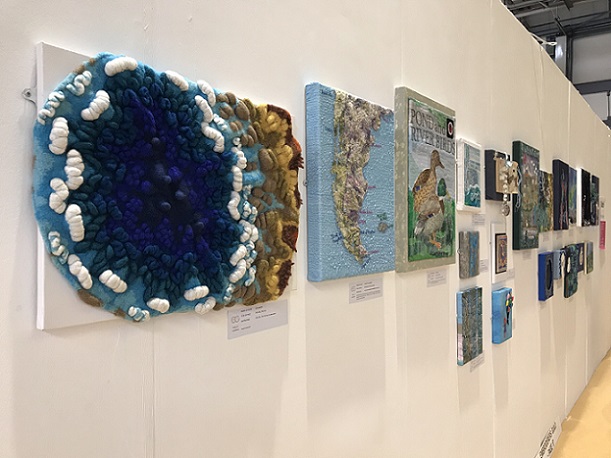
Another view of the 'blue wall'.
Many thanks to The Embroiderers’ Guild for this opportunity and to the curators, Alex Messenger and Amanda Smith. For more information about Page 17 at The Knitting and Stitching Shows, please scroll down.
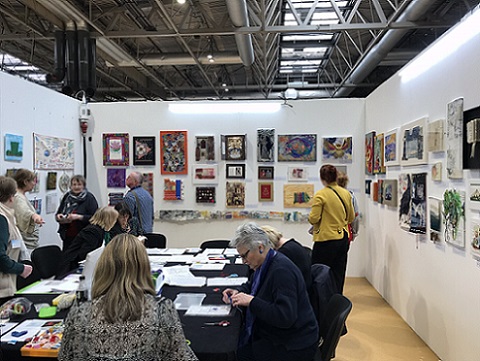
The Embroiderers' Guild stand was busy as a workshop was running;
the stitchers were surrounded by the more of the Page 17 exhibtion.
And here are some more images of The sea, the sea but also of the whole Page 17 exhibition:
1. Page 17, exhibition statement
2. Lou Baker, The sea, the sea, felted hand knitting installed as part of Page 17, The Fashion and Embroidery Show, NEC Birmingham
3. Detail of The sea, the sea
4. The sea, the sea and part of the outer ‘blue wall’ of Page 17
5. Another view of the ‘blue wall’
6. The outer, ‘blue wall’ of Page 17
7-11. More views of the Page 17 exhibition at The Fashion and Embroidery Show, NEC Birmingham
12 & 13. Views of the busy Embroiderers’ Guild stand surrounded by more of the Page 17 exhibition
2018 Intent, Part 1: an online art exhibition with Cultivate Gallery, London, and Organ, curated by Sean Worrall, January 16th 2018 - ongoing
Exhibition statement: 'Intent (part one) – The Intent is for an art show to happen in two parts in two places, the Intent is to have an art show in two parts with both parts happening at the same time. Intent (part one) follows our rather successful Cultivate on-line group show experiments of 2017, Intent (part two) will happen physically via the gallery walls and floors down in that underground basement gallery known as BSMT Space (over on the borders of Hackney in Dalston, London N16), part two will open two days after part one on January 18th 2018, part one is now open…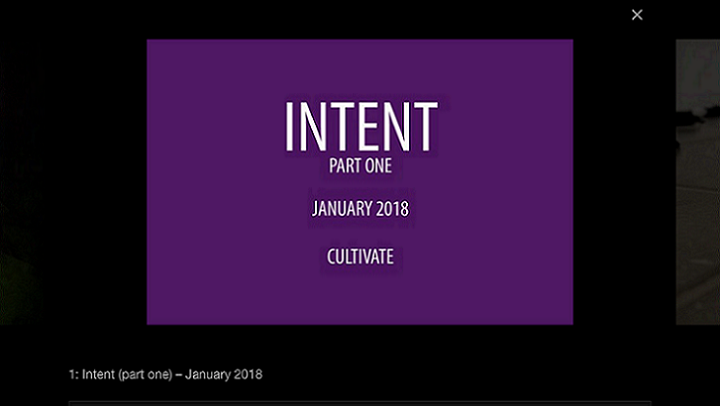
A screen print of the front page of Intent Part 1: an online exhibition
The intent then is for Cultivate to curate a show in two parts, this is part one, a carefully selected set of images, thirty artists and some intent for the new year, a combination of invitation and an open call, a show curated by Sean Worrall. Here then are the selected pieces, the 140 images of the art, the artists, the colour, the installations, the paintings, the leaves, the dances and the circles, do please run it as a slide show and enjoy it all, find the pieces you like then go explore more from the artists via the links that take you to their websites. You will find each piece numbered and that number corresponds with the notes at the foot of this page where you will find more about each artist as well as links. Intent (part one) then, welcome to the show, art excites, do enjoy….'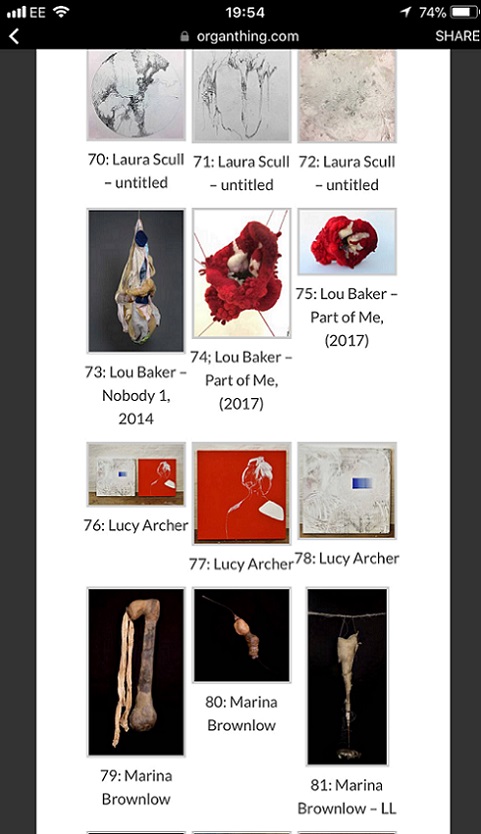
A screen print of part of Intent Part I: an online art exhibition
Have a look at Intent Part I: an online art exhibition here.
Artist's statement: 'Lou Baker is intent on her art; she’s obsessive, compulsive. Her processes are labour intensive and repetitive and as important as the product. When she’s making, she very quickly enters a state of meditative timelessness which creates a profound sense of well-being. The psychologist, Csikszentmihalyi, calls this the state of flow; it’s caused by deep concentration, where levels of skill match levels of challenge. It’s also linked to creativity and, ultimately to happiness.
Baker makes public things that are normally private. Exploring personal themes, her work becomes a form of therapy, and then a provocation as it resonates with others.'
Three images of my work are included in this rather unusual art exhibition: 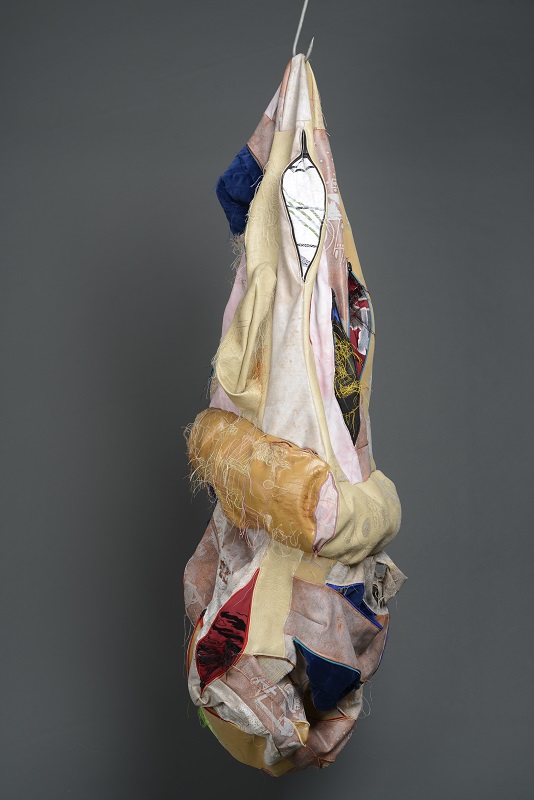
Nobody 1, 2014,
leather, imitation leather, velvet, hair, used clothing, zips; print, stitch
190 x 70 x 70 cm, 5.5kg approx
'Nobody 1 is part of a series of three soft sculptures, Nobodies, hanging from meat hooks and chains, which explore ways that cloth and stitch can evoke the abject in art. The abject is the instinctive feeling of horror ‘to a threatened breakdown in meaning caused by the loss of the distinction between self and other’. Using a series of photo cut-outs from a photo montage book Lou Baker made her son for his 18th birthday, the idea of ‘body, no body, nobody’ was born. Each photo has a distinctive cut-out shape, framed with a memory of a place or time. Baker’s work examines her responses to her only child leaving home and explores ways to communicate the mixture of emotions involved in this transition, in terms of identity and purpose, loss and absence, through the visual language of abjection. What is left behind when someone leaves?'
And two images of Part of me I: 
Part of me I, 2017, felted hand knitting,
installed at Synecdoche's Opposing positions exhibition
at Southmead hospital, Bristol with Fresh Arts, July 2017
'Lou Baker makes public things that are normally private. Parts of me is a new series in progress of smaller, hand knitted soft sculptures. Hours of slow, meditative work culminate in a relatively short, unpredictable process of alchemy which dictates the outcome. Felting produces a disquieting change in control, transforming the familiar, comforting, recognisable knitted fabric into something ‘other’, body-like and strange.
Here Part of me I is suspended with strands of red yarn in a locked glass cabinet in a hospital setting…..'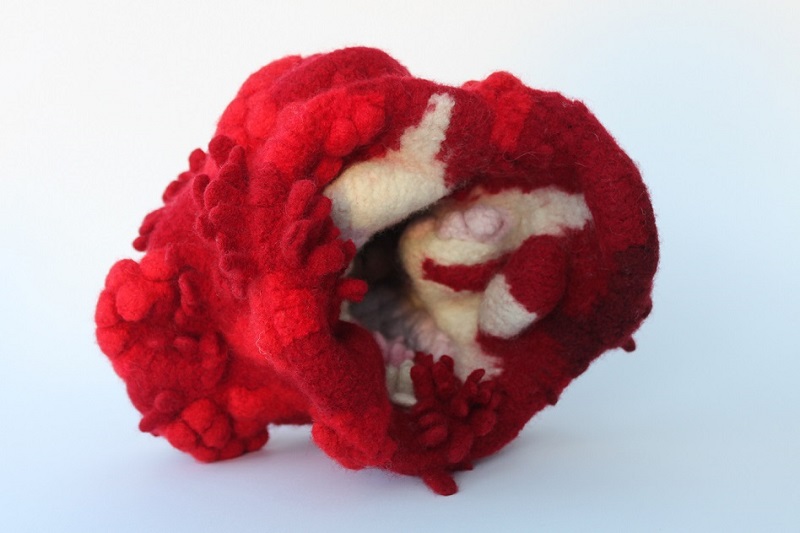
Part of me I, 2017, felted hand knitting, 21 x 20 x 20cm
2017
PRILIC, with Impermanence Dance Theatre, Jacobs Wells Baths, Bristol, December 8th-16th 2017
'PRILIC is an exhibition of dance, painting, sculpture, writing, music, performance, costume, ideas, photography and film. It celebrates the end of a tumultuous year. PRILIC also marks the end of an era for Bristol, with the former Dance Centre, which has been based in the old swimming pool Jacobs Wells Baths, changing hands imminently.
In a climate where the public and private spheres are ever more difficult to disentangle, and what we understand to be collective or owned by 'the individual' is becoming re-defined, often leading to conflict and distress on the personal, domestic and international level. Those who make art, whether overtly or otherwise, are engaged in imaginatively exploring how the human experience is portrayed in society, thus offering a space to reflect upon how the human and society can interact.'
Lou Baker's Multitude at PRILIC, December 2017
Exhibiting artists include:
Andrew Burns Colwill, Jo Bansall, Anna Mazzotta, Emma Caton, Lou Baker, Nick Harvey, Julian Quaye, Mary Rouncefield, John Curtis, J. West, Silent Hobo, Pam Tait, Meg Buick, Theo Kane, Rosanna Morris , Ian Thomson, Doug Francisco, Roseanna Anderson, Matt Webb & Lorenzo Pratti, Daniel Hay-Gordon, Tim Martin, PETER, Ivan Gololobov, Project O, Claudia Palazzo, Frisky, The Greeners, Pink Suits & Josh Ben-Tovim
Entry is free and PRILIC will be open from 10-7 each day (except Sunday 11-4)
Please see the programme for a list of events.
PRILIC is supported by Karen Van Hoey Smith
Read an interview about PRILIC with Josh Ben Tovim
Watch a video of my installation of soft sculptures, Multitude, at PRILIC
Watch a video of Josh Ben Tovim and Roseanna Anderson of Impermanence Dance Theatre responding to my soft sculptures
Read a blog by Gilli AuntieG of the Kane Gallery
See Multitude for more information and images of the installation of 11 of my soft sculptures at PRILIC.
Gallery of images of PRILIC
1. PRILIC timetable of events
2. PRILIC poster
3. PRILIC exhibition statement
4-9. Lou Baker’s Multitude
10. Lou Baker’s Multitude, label on blackboard paint
11-13. Lou Baker’s Multitude
14. The Greeners at PRILIC Opening night, 8.12.17
15, 16. Lou Baker’s Multitude
17. ‘Open’, old swimming pool reception
18. PRILIC
19,20. Doug Francisco
21. Doug Francisco and Jon Curtis
22. Anna Mazzota
23, 24. PRILIC
25. Lou Baker
26, 27. PRILIC
28. Julian Quayle
29-36. Lou Baker’s Multitude
37. Lou Baker’s Multitude and Pam Tait’s Black boys and white ladies
38. Roseanna Anderson’s dance performance, 15.12.17
39. Film viewing, 15.12.17
40-43.Lou Baker’s Multitude
44-47. PRILIC
48-53. PRILIC Opening party, 8.12.17, featuring Impermanence Dance Theatre, Pink Suits and The Greeners
Page 17, with The Embroiderers' Guild, at The Knitting and Stitching Shows, London, October 11th -15th 2017, The Knitting and Stitching Show, Harrogate, November 23rd - 26th 2017 curated by Amanda Smith and Alex Messenger
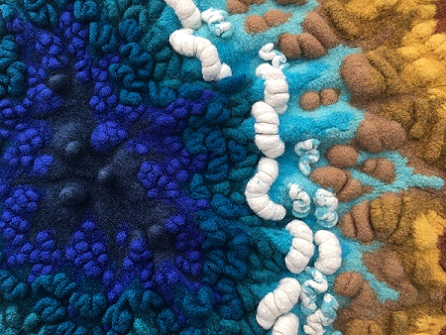
Lou Baker's The Sea, the sea, 2017, detail, felted hand knitting
Exhibition statement:
‘So what books do you have on your bookshelf? Do you like fiction or fact? Do you warm to a frothy Barbara Cartland romance; grip the edge of your seat with a gritty John Grisham thriller, or lose yourself in a Philippa Gregory history? Whatever you read, the words will form pictures in your head. Now The Embroiderers' Guild is proud to introduce "Page 17" – a specially created exhibition of textile artistry where each piece takes a book as its inspiration. Seen for the first time at Knit & Stitch London, EG has bought together a unique group of artists who bring words to life. This is a unique and exciting display of work, with pieces from well-known textile artists, new names and many members from around the country. By using techniques as diverse as machine and hand stitching, mixed media and felting (to name a few), you will see mischievous monkeys and strutting chickens, mathematical Pi and electrical circuits, Greek tragedy, Jane Austen and Haiku poetry. Using colour and form, design and texture, members have created works which span the contemporary, the literal and the symbolic. Your imagination will be intrigued as it follows the thread across the surface, and marvels at how the combination of cloth and thread is both a medium and metaphor, bringing to life images hidden amongst words. Visit the Embroiderers Guild stand and see if your favourite book is on display.’
My felted hand knitted piece, The sea, the sea is inspired by the book of the same name by Iris Murdoch. I have written more about the processes and outcome here and more general reflections about knitting in my blog post I knit therefore I am.
Here are some images of The sea, the sea as a work in progress, and the final piece:
1. 22.7.17 It begins! Multiple double pointed needles used to knit central wave peaks in the round #ascomplicatedaspossible #knittingastherapy #iknitthereforeiam #streamofconsciousness
2. 24.7.17 It continues….
3. 26.8.17 Photoshoot on Putsborough beach, North Devon. Four weeks of intense knitting later and it’s nearly there….
4. Photoshoot on Putsborough beach, North Devon.
5. Photoshoot on Putsborough beach, North Devon.
6. Photoshoot on Putsborough beach, North Devon.
7. Photoshoot with a gin and tonic
8. 28.8.17 To felt or not to felt? The sea, the sea before felting
9. Detail of The sea, the sea before felting
10. Reverse of The sea, the sea before felting
11. Detail of the reverse before felting
12. 28.8.17 Felting the knitting in the washing machine
13. 28.8.17 The felted piece before I cut off the ends
14. 29.8.17 Mounted on the canvas
15. Detail of The sea, the sea, felted hand knitting
16. Detail of The sea, the sea, showing the sculptural texture
17. Detail of The sea, the sea
18. The sea, the sea in situ at Page 17 exhibition at The Knitting and Stitching Show, Alexandra Palace, London
19. Logo for Page 17 exhibition
Refuge: in search of safety, Fringe Arts Bath, 26th May to 11th June 2017, curated by Mike and Dona Bradley
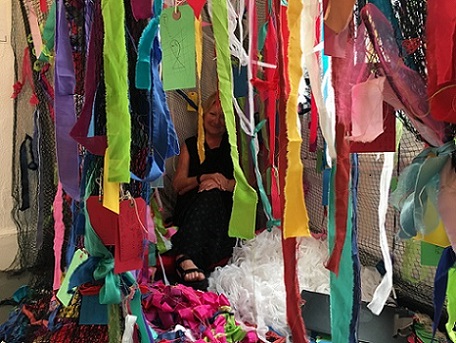
Lou Baker inside Safety net at Refuge: in search of safety, Fringe Arts Bath, Day 17
Exhibition statement:
'Do you ever stop to examine what makes you feel safe?
This thought-provoking exhibition gets to the heart of what it is that could make any of us seek refuge from harm, from fear, from circumstances beyond our control.
We all share a need to feel safe, and to help those we love feel the same. But in our stressful lives, facing an uncertain future, safety is often just an illusion.
Beginning as a response to the refugee crises of the past few years, this exhibition grew to include not only refuge from war or persecution but aspects which seem much more familiar: refuge from physical harm, illness, homelessness.
We bring together a varied group of artists, each of whom explores the theme in a deeply personal way. Between them they seek to help us understand what it is that gives us our sense of safety, or takes it away. Is refuge a place, a person, a state of mind? What lengths would we go to if this was threatened?
A dramatic exhibition featuring a range of media, from paintings and photography to video poetry, sculpture and stunning installations, it uncovers the humanity in our shared search for that feeling of safety.'
Venue: FaB 2, 94 Walcot Street, BA1 5BG
Open 10am to 6pm - Sat 27 May to Sat 10 June and 10am to 3pm Sun 11 June
Have a look at details and images of my walk-in, participatory installation, Safety net, and how it was transformed over the 17 days of the exhibition.
Here's a walk through video of the exhibition by Dona Bradley.
And here is a gallery of some general images of the Refuge exhibition:
We need to talk about clothes by Threadcounts at Hardwick Gallery, Cheltenham, April 18th -26th
‘Each year in the UK we send around 350,000 tonnes of used clothing to landfill. Seeing as it could be re-used or recycled, this is a tragic waste. If you think about it in economic terms, that’s around £140 million pounds worth of clothing being chucked in the bin. No one would throw money in the bin, so why do we do it with clothes?
The average UK household owns around £4,000 worth of clothing – yet we never have anything to wear! – and on average, 30% of the clothes in our wardrobes haven’t been worn in the last year. This might be because it doesn’t fit any more or it’s looking a bit bedraggled, but mostly it’ll be perfectly useable.’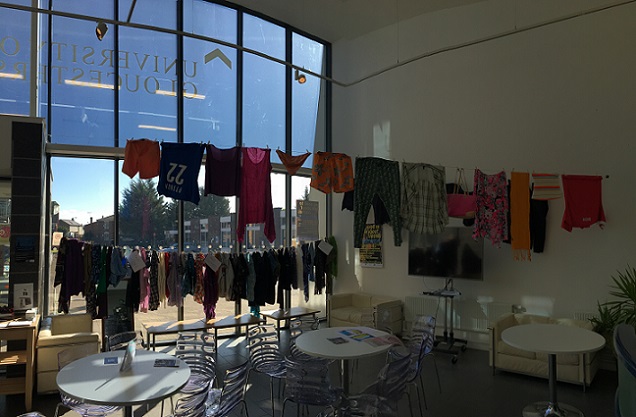
Lou Baker's interactive installation, Don't wash your dirty laundry in public,
used clothing, washing line, pegs,
installed in the cafe at 'We need to talk about clothes' exhibition, Hardwick Gallery
The clothes were free for people to take away.
'We need to talk about clothes' was a week long exhibition at Hardwick Gallery, at the University of Gloucester, Cheltenham campus. It was organised by Thread Counts, a collaboration between Hardwick Gallery, Atelier (Stroud) and Fashion Design at the University of Gloucestershire for sustainable textile futures. On Saturday 22nd April, 10.30am-4.30pm, Thread Counts held a Maker’s Day event in the University that included a gallery tour, panel discussion, and maker’s spaces upcycling workshops and demonstrations during which I was invited to talk about my work.
My interactive installation, Don’t wash your dirty laundry in public was installed in the café area of the University and, once again, the clothes were free for people to take away. However, unlike it’s incarnation at Synecdoche's Bodies residency in September 2016, I wasn’t able to be there to set up the installation or to rehang it as the exhibition progressed. Instead, many thanks to Jamilla Ives, one of the fashion technicians, who set it up for me. It looked amazing and was an interesting change in control!
I was delighted that the Selvedge blog featured an article about my work:
Read the Selvedge blog about my work at 'We need to talk about clothes' exhibition, 19.4.17
And here are 3 screen shots of the blog: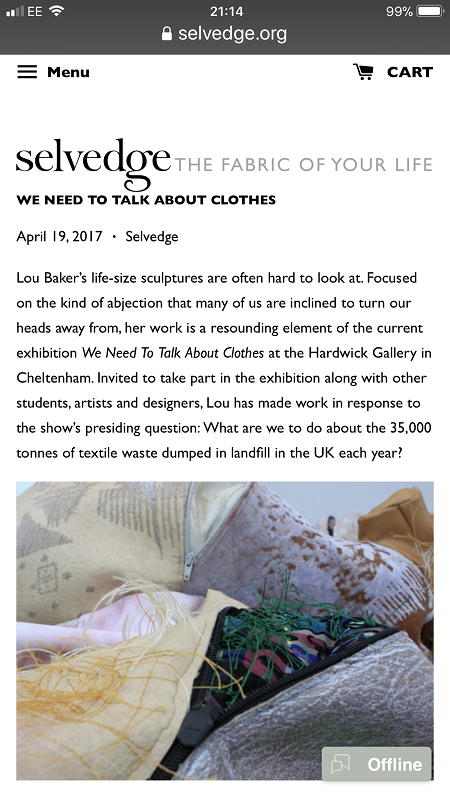
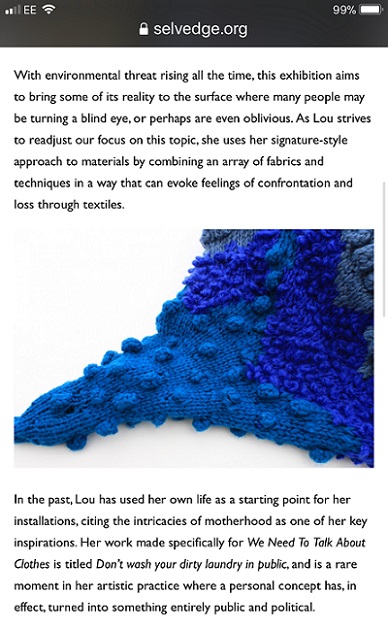
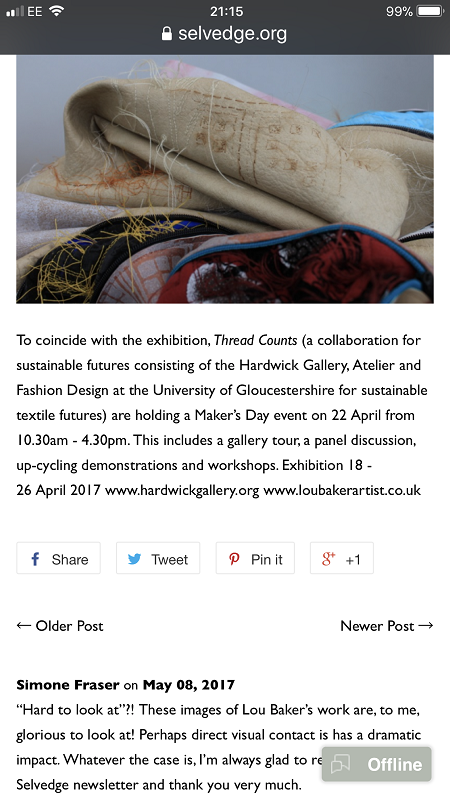
One of the other artists in the exhibition, Jane Glennie, also wrote about it in her blog.
Here is a video about the exhibition.
And here's a gallery of images from the exhibition and the Makers’ Day:
1. We need to talk about clothes poster
2-15. Views of my installation Don’t wash your dirty laundry in public in the café area
16, 17. Participants rummaging amongst my clothes
18. View of the exhibition in the main gallery
19. Me talking about my installation during the Makers’ Day, photo Jane Glennie
20-22. Details of some of the other works in the exhibition
23. Jane Glennie, Pressure front
24. Lorna Jewitt, Old hat
25. Katherine Sullivan, Perch
26-28. Crocheting with recycled clothing workshop on the Makers’ Day
29. I was very pleased with my attempts at sculpting with crochet using cut up tshirts!
Red: an online art exhibition, presented by Cultivate, curated by Sean Worrall, February 27th 2017, ongoing

Click here to see Red, an art exhibition online
‘Cultivate presents (in association with Organ) RED, an art exhibition on line. The notion is simple, an online art exhibition, curated and presented online. Twenty four artists selected via an online open call or by invitation, alongside images from previous Cultivate shows, along with other observations (and that red feeling while waiting for the Julie Ruin). Sixty seven images, selected pieces of art or images of art or images from art events or red observations, presented by the ever evolving thing that is Cultivate.
This time we Cultivate on line, sometimes we do it in formal galleries, or in warehouses or at dog shows or under railway bridges or in car parks at the seaside, this time we do it online. A group show featuring the art of 24 selected or invited artists.
Red went live on-line at 6pm (UK time) on Monday 27th February. Presented by Cultivate, in association with Organ and curated by Sean Worrall.’
I was delighted that images of three of my red soft sculptures were selected for this rather unusual exhibition! 
Heart of darkness, 2016-present, diptych, hand knitted wool, chains, meat hook,
installed at Synecdoche's Bodies residency, September 2016
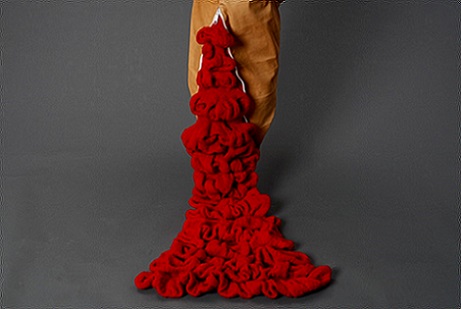
Other 5, detail, 2015, leather, zip, hand knitted wool
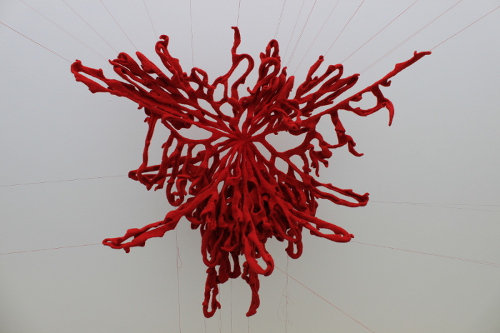
All the babies I might have had I, 2010, felted hand knitting,
installed at Align at UWE's Bower Ashton campus (scroll down for further details of this exhibition)
Window Wanderland, 212 Gallery, Bristol, February 4th- 9th 2017
I was invited to install one part of my large, red, hand knitted soft sculpture, Heart of darkness, as part of the Valentine’s Day window display for a local shop and gallery, Room 212 on Gloucester Road in Bristol. It also coincided with a weekend community event, Window Wanderland, where local residents in Bishopston decorate and illuminate their front windows for the public to view from the street. Some of the local shops and businesses take part as well.
Room 212 has a double bay shop window; for the Window Wanderland weekend my knitting formed the backdrop to one window and in the other there was a sound and video installation by Theadora Ballantyne-Way. It was stunning! I was thrilled, once again, to see how my knitting is site responsive.
One part of Lou Baker's hand knitted Heart of darkness in the window of Room 212
Statement on Room 212’s website:
‘Window Wanderland took place during the weekend of 4th-5th February. This is a wonderfully creative event in our neighbourhood and we enjoyed taking part. Our window display combined thoughts of our community and Valentine’s Day to focus on the Heart – from the anatomical to the symbolic. There was a visual installation by Theadora Ballantyne-Way and a textile sculpture from Lou Baker.’
Artist’s statement for Window Wanderland at Room 212:
‘Lou Baker challenges the stereotypical expectations of knitting in many ways. She blurs the boundary between craft and fine art by adapting and developing established knitting techniques to create sculptural forms which provoke a range of conflicting responses. Her work forges intellectual connections between material, process and concept, exploring meaning by combining the traditional with the surprising. The soft, impermanent nature of yarn, as an unconventional medium in fine art, adds to the meaning it conveys; the hanging knitted form, suspended using tension and gravity,suggests a vulnerability which evokes a bodily resonance with notions of absence and the abject; the language of knitting adds poignancy to her work- ‘tension’, ‘unravelling’, ‘cast off’…
Baker knits compulsively, pushing boundaries in terms of sculptural knitting, creating large-scale, abstract installations. She regards knitting as a physical drawing, the transformation of a linear material into a three-dimensional form. For her, the process of knitting is as important as the product; she gives herself a few rules, makes decisions as she knits and the sculpture develops intuitively. She calls it her ‘stream of consciousness’ knitting.
For Baker, knitting and thinking are inextricably linked. Knitting in private, she quickly enters a state of meditative timelessness which induces deep thought and a profound sense of wellbeing. The psychologist Csikszentmihalyi describes this as the state of flow; it is caused by deep concentration, where levels of skill match levels of challenge. It is often linked to creativity and, ultimately, to happiness. Knitting in public, however, acts as a people magnet, initiating interactions with friends and strangers. Baker regards her knitting as a memory catcher, as she manipulates the knitted line into a net which captures thoughts, memories, emotions and conversations. These in turn become part of the physical piece.
Using knitting, Baker explores the transformation of materials and the sculptural and mark-making potential of stitch; finding her own irregular and unpredictable pattern, her troubling forms create an uneasy tension in aesthetics and examine the possibilities of there being a dark side to the perceived notions of knitting as a gendered, decorative, safe, clean, perfect and private pursuit.’
2016
The Memory of Space, Centrespace Gallery, Bristol, November 25th-30th 2016
Part of Epigram's review of Memory of Space,
'Memory, the self and the conflicts of modernity' by Esther Bancroft
Students and alumni from the Drawing and Applied Arts/Drawing and Print BA programme at UWE present an exhibition of work in response to the idea, ‘Memory of Space – Space of Memory’. They were invited to respond to the title by Jan-Phillip Fruehsorge, an international curator based in Berlin, and Director of Fruehsorge Contemporary Drawing Gallery and The Drawing Hub, Berlin. The exhibition features work in a range of media, and with a range of responses to the provocation; some theoretical, some emotional, some literal.
Check out the full Epigram review of the exhibition here, including an interview about my soft sculpture. Sadly the images are now no longer there.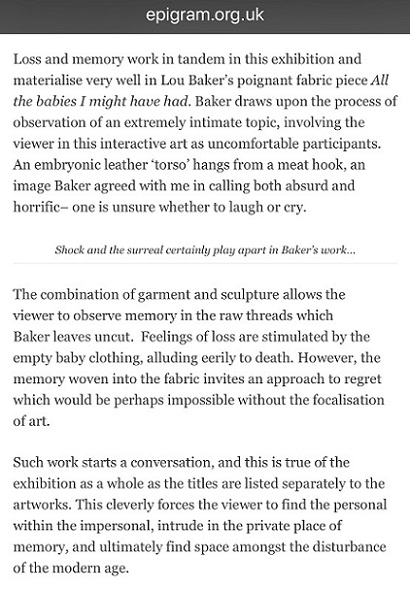
More of the Epigram review about my work, All the babies I might have had II
Gallery of images from 'The Memory of Space':
1. Screen shot of Epigram’s review of The Memory of Space
2. The Memory of Space poster, artist Richard Webb
3. Lou Baker’s All the babies I might have had II
4.-9. All the babies I might have had II, detail
10. Memory of Space, details of the exhibition
11.-17. The Memory of Space, exhibition images
Unravelling: an exhibition of knitting and crochet art, Bow Arts, Ice House Studios, London IG11 7BT, October 6th -16th 2016
Exhibition statement:
'Unravelling, a collaborative exhibition which showcases the diversity of what is possible using only yarn and the simple tools of needles or hooks.
Lou Baker's hand knitted diptych Heart of darkness installed at Unravelling
Yarn is an unconventional medium in art and can provoke a range of conflicting responses. Its softness brings to mind the comfort of the things we wear closest to our skin, whereas its impermanence can remind us of our mortality. Using knitting and crochet, with their gendered associations with the domestic and the private, adds further meanings to its presence in a gallery.
Everybody’s ‘doing it’- in the living room, on their bed, in the garden, on the bus; we’ve come out of the closet. Now you can spot knitters clicking away in pubs, crocheters crafting their yarn on the tube. Knitting and crochet have become a means of self-expression; they are like brushes for the painter, pen and paper for the author and clay for the sculptor. From the functional to the abstract, from socks to sculptures, it truly is the art of creating something from nothing.
Knitting and crochet break down barriers, bringing together people from different backgrounds, countries and ages. Knitting groups are set up every week in pubs, cafes and shops. A silent revolution has started against mass production, the cheap and cheerful, the unsustainable and the disposable.
Supported by Bow Arts Trust, and coinciding with The Knitting and Stitching Show at Alexandra Palace, Wool Week and the British premier of Yarn:The movie, Unravelling will explore how yarn can be transformed using these two highly versatile processes, blurring the boundaries between craft and art.'
Unravelling had a fleeting visit from Sadiq Khan, the Mayor of London. Watch a video of him giving my Heart of darkness a nod! Also, have a look at Bow Arts' website and many thanks to Jonny Baker for his blog post, at sea - unravelling.
Unravelling: an exhibition of knitting and crochet art.
6th -16th October 2016, Thursday to Sunday 12:00 to 18:00
The artists are:
Lou Baker
Billy Black
Karen Haskett
Gosia Dzik-Holden
Harriott Knuckles
Karen Jocelyn Mayor
Alessandra Rigillo
Jess Rippengale
Christina Rogers
Kerry-Fleur Schleifer
Like and follow Unravelling on:
Facebook
Twitter
Instagram
Gallery of images of Unravelling:
1.Lou Baker's Heart of darkness, 2015 - present, work in progress, hand knitted wool, knitting needles, yarn, meat hook, chain
2. Lou Baker's Nobody 3, 2014, hand knitted wool, knitting needles, yarn
3. Lou Baker's Psychedelic sunset 1/2, 2010, hand knitted felt (Photo by Jonny Baker)
4. Lou Baker's Psychedelic sunset 2/2, 2010, hand knitted felt
5. Lou Baker's All the babies I might have had I, 2011, from inside (Photo by Jonny Baker)
6. All the babies I might have had I, 2011, from outside (Photo by Jonny Baker)
7. General view of Unravelling, Room 1
8. We had a brief visit from Sadiq Khan, the Mayor of London, and his entourage!
9. Heart of darkness
10. Heart of darkness
11. General view of Unravelling, Room 1
12. Shroud, 2013, hand knitted wool, from inside (Photo by Jonny Baker)
13. Shroud, 2013, hand knitted wool, from outside
14. General view of Unravelling, Room 1
15. General view of Unravelling, Room 2
16. General view of Unravelling, Room 2
17. Lou with Nobody 3
18. Most of The Unravellers
Privy: an exhibition of public and private stuff, featuring Lou Baker, Maura Zukina and Nicola Pearce, at The Edwardian Cloakroom, Bristol, June 22nd to 28th, 2016
Lou Baker's stitched soft sculpture Other 5
installed in one of the toilet cubicles at Privy
Exhibition statement:
Privy [priv-ee]
adjective:
1. participating in the knowledge of something private or secret
2. private; assigned to private uses.
3. belonging or pertaining to some particular person
4. secret, concealed, hidden, or secluded.
5. acting or done in secret
noun:
toilet
Lou Baker, Nicola Pearce and Maura Zukina present an exhibition of public and private stuff. Come on in – it’s a weird and wonderful world.
loubakerartist.co.uk @loubakerartist
nicolapearce.co.uk @nicolapearce_
maurazukina.com mozthemotherhen.tumblr.com
Gallery of images of Privy:
1. Detail of Lou Baker’s All the baby I might have had II
2. Detail of Lou Baker’s Nobody 5, installed in one of the toilet stall
3. General view of part of Privy, with several of Nicola Pearce’s works
4. Detail of Maura Zukina’s work
5. Maura Zukina
6. Nicola Pearce, writing performance
7. Nicola Pearce, site specific installation of ‘Fragile’ tape
8. General view of part of Privy, including 2 of my soft sculptures, Nobody 1 and Other 4
9. General view of part of Privy, including one of my soft sculptures, Other 4
10. Maura Zukina’s Privy bag
11. Lou Baker’s Other 1
12. Lou Baker’s Other 5
13. Nicola Pearce, found, flattened cans
14. General view of part of Privy, with some of Maura Zukina’s ceramics and metal work and Nicola Pearce’s photo documentation
15. General view of part of Privy, looking through to Lou Baker’s Other 1
16. General view of part of Privy, including 2 of my soft sculptures, Nobody 1 and one part of Heart of darkness
17. Maura Zukina’s Kinky boots
18. Lou Baker, impromptu performance, Wearing the unwearable, Heart of darkness 1 worn by the artist
19. Lou Baker, impromptu performance, Wearing the unwearable, Heart of darkness 1 worn by the artist plus part of Nobody 1
20. Lou Baker’s Nobody 1
21. General view of part of Privy, including 2 of my soft sculptures, Nobody 1 and one part of Heart of darkness
22. General view of part of Privy, including one of my soft sculptures, All the baby I might have had II
23. Maura Zukina’s ceramic fists
Cartesian Cut?, Fringe Arts Bath, May 27th to 12th June, 2016, curated by Eloise Govier
Lou Baker's Nobody 1 installed at Cartesian cut?
Exhibition statement:
'The ‘Cartesian Cut?’ revealed and unraveled the boundary of the body. The title of the exhibition relates to the philosopher René Descartes (1596—1650) who made a clear distinction between the mind and body. Contemporary philosopher Karen Barad problematises his boundary, calling it the ‘Cartesian cut’ (2003: 815). Contra-Descartes she offers an understanding of entities not as unique beings but ‘phenomena’ in constant ‘intra-action’ (2003: 815). Inspired by her argument, artworks in the exhibition explored the porous and fluctuating boundary of the body.
Artist Eloise Govier curated the exhibition, she explains “the exhibition offered unique imaginings and interpretations of the workings of bodies. We were open to all mediums but particularly wanted to showcase artworks that offered sensitive and innovative commentaries on the body.”'
For more information have a look at The Cartesian Cut? exhibition catalogue and Eloise Govier's website
Artist's statement:
‘The abject marks the moment when we separated ourselves from the mother, when we began to recognize a boundary between ‘me’ and other, between ‘me’ and (m)other’ (Kristeva in Felluga, 2011).
Nobody I and All the babies I might have had II are life-sized, soft sculptures, hanging from meat hooks and chains, which use cloth and stitch to evoke the abject. Through them Lou Baker explores the separation between ‘me’ and (m)other, from a mother’s perspective. The feminist critical theorist, Julia Kristeva, also describes the abject as the instinctive feeling of horror ‘to a threatened breakdown in meaning caused by the loss of the distinction between self and other’ (1982).
All the babies I might have had II, 2015,
leather, imitation leather, hand knitted felt, used clothing, zips; stitch, print
installed at Cartesian Cut?, Fringe Arts Bath May - June 2016
Inspired by the discarded, frame-like remains of the photos she had cut up to make a photo montage book for her only son for his 18th birthday, Baker developed the idea of ‘body … no body … nobody’. Sculpted using a selection of skin-like materials and her son’s old clothes, these disturbing body-like forms examine her responses to her only child growing up and leaving home and the impact that has had on her life. They communicate the depth and range of emotions involved in this transition, in terms of identity and purpose, loss and absence, through the visual language of abjection. Memories and the emotions they elicit vary in intensity and clarity; some are public and shared, some are private and hidden. Using zips as a device to visualise the liminal space between that which is revealed and that which is concealed, Baker provides a potentially changeable threshold between her interior and exterior selves which blurs boundaries and adds poignancy to the precarious separation between self and other.
What is left behind when someone leaves?
That Baker chooses to use cloth and knitting in sculpture, with their associations with craft and the feminine, powerfully subverts traditional representations of the body. The soft, impermanent nature of cloth evokes the human form and its mortality, revealing alternative meanings in its folds and surfaces. There are multiple femininities associated with used clothing, recycled imitation leather and human hair linked to dirt and contamination anxiety which also add meaning to her choice of materials. She has researched the ways other artists, especially Christian Boltanski and Louise Bourgeois, use empty second-hand clothing in their work to suggest a physical absence and ultimately, death, the most extreme abjection. By hanging her sculptures, Baker also conveys a sense of vulnerability and ambivalence which contrasts powerfully with the violent intensity of the piercing with meat hooks, and the chains.
Nobody I, 2014, installed at Cartesian Cut? with Nikki Alford's installation of tape
There is a merging of the senses of touch and sight associated with cloth; it can be regarded as an extension of the body, a second skin. Its materiality and skin-like nature provides an alternative range of meanings to the use of clothing in art, operating ‘both through the haptic and the scopic simultaneously’ (Dormor 2008: 240). Each discarded photo has a distinctive cut-out shape, framed with a memory of a place or time. Baker captures these memories, using a range of traditional textile processes,including embroidery, quilting, knitting and flocked printing, amongst others, to create unsettling abstract images, and surfaces which blur the visual / tactile divide. The materiality of clothing can involve the sense of smell too, which can also powerfully evoke memory. Here, some of the clothing has that distinctive second-hand, musty smell and the imitation leather emits its own peculiar odour. This adds to the abjection and increases the immersive experience.
Exploring the transformation of materials and the sculptural and mark-making potential of stitch, Lou Baker creates an uneasy tension in aesthetics by challenging the seemingly benign nature of textile processes and evoking the abject. Individually, the sculptures are alluring yet troubling; as a series they are imposing, an uncanny bodily presence. Baker forges intellectual connections between material, process and concept, underpinning her investigations into the dialogue between personal memories and universal themes as she comes to terms with the separation between self and other.
Dormor, Catherine, 2008, ‘skin: textile: film’ in Textile, Volume 6, Issue 3, pp 238-253
Felluga, Dino, 2011a, Modules on Kristeva, Introductory guide to Critical Theory, Available from: http://www.cla.purdue.edu/english/theory/psychoanalysis/kristevaabject.html [Accessed 27 September 2013]
Kristeva, Julia, 1982, Powers of Horror, Columbia University Press: New York
Parker, Roszika, 2010, 3rd edition, The Subversive Stitch: Embroidery and the making of the feminine, London: Tauris
Gallery of images of Cartesian Cut?:
Pattern, Fringe Arts Bath, May 27th to 12th June, 2016, curated by Laura Waite & Nicola Pearce
Exhibition statement:
'In visual terms pattern traditionally infers ideas of decoration - marks, lines, dashes and dots. In practice pattern is usually a set of instructions to be followed. Day to day you find patterns by chance, in behavior; breaths, wakeup times or work routes. This exhibition will explore the boundary of what pattern is - the way patterns are made, produced, found and pulled apart.'
Artist's statement:
'Knitting is generally regarded as a benign, gendered, functional pursuit, but what happens when the knitter subverts these expectations? Most knitters follow a knitting pattern in order to replicate someone else’s design; a garment, a blanket or an accessory, maybe. What happens when there is no pattern, or rather, when a pattern is established through a pattern of behaviour, or through a stream of consciousness, or when it is led by an unpredictable change in control? And what happens when the knitted piece is abstract, emotive and disturbing? 
All the babies I might have had I, 2010,
felted hand knitting,
installed at Pattern, Fringe Arts Bath, May - June 2016
Lou Baker challenges the stereotypical expectations of knitting in many ways. She blurs the boundary between craft and fine art by adapting and developing established knitting techniques to create provocative sculptural forms which evoke an abject response. Her work forges intellectual connections between material, process and concept, exploring meaning by combining the traditional with the surprising. The soft, impermanent nature of yarn, as an unconventional medium in fine art, adds to the meaning it conveys; knitting with unexpected materials such as plastic or metal adds another dimension. Her troubling forms create an uneasy tension in aesthetics and examine the possibilities of there being a dark side to the perceived notions of knitting as a gendered, decorative, safe, clean, perfect and private pursuit. The language of knitting takes on new meanings in a fine art context; ‘tension’, ‘unravelling’, ‘casting off’, ‘blocking’ and ‘spinning a yarn’, amongst others, adds poignancy to her work.
Baker knits compulsively, pushing boundaries in terms of sculptural knitting, creating large-scale, abstract forms. She regards knitting as a physical drawing, the transformation of a linear material into a three-dimensional structure. For her, the process of knitting is as important as the product; she gives herself a few rules, makes decisions as she knits and the sculpture develops intuitively. She calls it her ‘stream of consciousness’ knitting.
General view of Pattern exhibition, including All the babies I might have had I
For Baker, knitting and thinking are inextricably linked. Knitting in private, she quickly enters a state of meditative timelessness which induces deep thought and a profound sense of wellbeing. The psychologist Csikszentmihalyi describes this as the state of flow; it is caused by deep concentration, where levels of skill match levels of challenge. It is often linked to creativity and, ultimately, to happiness. Knitting in public, however, acts as a people magnet, initiating interactions with friends and strangers. Baker regards her knitting as a memory catcher as she manipulates the knitted line, transforming it into a net which captures thoughts, memories, emotions and conversations. These in turn become part of the physical piece.
The process of felting is alchemy; months of slow, meditative work culminate in a relatively quick, unpredictable process which dictates the outcome. This change in control brings a vulnerability to Baker’s work, underpinning her investigations into the dialogue between personal memories and universal themes.
Using knitting, Baker explores the transformation of materials and the sculptural and mark-making potential of stitch; finding her own irregular and unpredictable pattern, she evokes a bodily resonance with notions of absence and the abject.'
I was also asked to write specifically about All the babies I might have had I, the hand knitted, felted sculpture that features in this show. Read more about it in my blog post, All the babies I might have had? and on the Pattern website here.
Gallery of images of All the babies I might have had I at Pattern:
2015
Artist's statement:
Attraction and repulsion, horror and hilarity; provoking a range of conflicting responses, Lou Baker’s hanging soft sculptures explore individuation, a process which, according to Carl Jung, needs to occur in the second half of life, of finding meaning in life. It is ultimately a preparation for death. Jung talks about balancing our multiple selves with the dark side, or shadow, of ourselves and maintains that failure to acknowledge and accept this shadow can result in fragmentation and associated mental health issues. He also describes the shadow as being the seat of creativity, and creativity is linked to happiness.
Baker’s work challenges stereotypical, gendered expectations of work with textiles in many ways. It blurs the boundary between craft and fine art by using traditional stitch techniques to create subversive sculptural forms which evoke an abject response. Her emotive forms and gestural stitches excavate the possibilities of there being a dark side to the perceived notions of embroidery as a gendered, decorative, safe, clean, perfect and private pursuit.
Baker regards her work as a form of self-portrait, a reflective and emotive response to the ongoing excavations of her dark side; an embodiment of a mid-life crisis. However, there is also a playful aspect to her work. That many people see genitalia is one; sculpting her aging body as an assortment of oddly quilted, saggy body bags is another! ‘They can be whatever you want them to be.’
Baker’s investigations into the transformation of materials and the sculptural and mark-making potential of stitch subvert conventional representations of the body, forging intellectual connections between material, process and concept. She creates an uneasy tension in aesthetics by challenging the seemingly benign nature of traditional textile processes and evoking the abject.
Gallery of images from The Knitting and Stitching Show, Harrogate:
The Embroiderers' Guild Graduate Showcase, The Knitting and Stitching Show, Alexandra Palace, London, October 7th-11th, 2015
'Memories and the emotions they elicit vary in intensity and clarity; some are public and shared, some are private and hidden. Exploring the gendering of materials, Lou Baker’s soft sculptures excavate the dark side of stitch, revealing and concealing alternative meanings in their folds and surfaces. She creates an uneasy tension in aesthetics by challenging the seemingly benign nature of traditional textile processes and evoking the abject.
Baker’s investigations into the transformation of materials and the sculptural and mark-making potential of stitch subvert conventional representations of the body, forging intellectual connections between material, process and concept. Using skin-like materials, she considers each stitch as a piercing and stitched drawings as tattoos; other textile techniques she sees as branding and scarification. Through careful consideration of form, colour and complex surfaces, she blurs the boundary between visual and tactile experience and evokes a bodily presence with notions of absence and the abject.’
Many thanks to @paisleypedlar for her blog post about my work at the K&S Show, London, All stitched up at Knit and Stitch
Gallery of images from The Knitting and Stitching Show, London:
The Degree Show, University of the West of England, Bower Ashton Campus, Bristol, June 5th -11th, 2015
Artist's statement:
Exploring the gendering of cloth and stitch, Lou Baker's soft sculptures reveal and conceal alternative meanings in their folds and surfaces. By transforming skin-like, impermanent materials and investigating the sculptural and mark-making potential of stitch, she subverts traditional representations of the body, forging intellectual connections between material, process and concept.
Through careful consideration of form, colour and complex surfaces, her work blurs the boundary between visual and tactile experience and evokes a bodily presence with notions of absence and the abject.
Gallery of images from The Degree Show:
Symbiosis, Phoenix Cafe, Bristol, April 2015
Exhibition statement:
‘sym·bi·o·sis n.
1. (biology) Interaction between two different organisms living in close physical association, typically to the advantage of both.
2. A relationship of mutual benefit or dependence.
Opening over Easter weekend, Symbiosis is an exhibition, an exchange of ideas, a meeting point for conversation and beautiful art work. Situated at Phoenix, a creative hub in the heart of Bristol. It is curated by four MA Curating students at UWE and attempts to bring work not usually shown into an environment that benefits both the venue and the artists.’
Artist’s statement:
‘Lou Baker’s knitting is a physical drawing, the transformation of a linear material into a sculptural form. Her soft sculptures challenge the gendered expectations of work with textiles, forging intellectual connections between material, process and concept. The hanging knitted form, suspended using tension and gravity, suggests a vulnerability which evokes a bodily resonance with notions of absence and the abject.
For Baker, the process of knitting is as important as the product. Knitting in private is her ‘stream of consciousness’ knitting - she has no pattern just a few rules, makes decisions as she knits and the form develops intuitively. She very quickly enters a state of meditative timelessness which induces a profound sense of wellbeing. The psychologist Csikszentmihalyi describes this as the state of flow; it is caused by deep concentration, where levels of skill match levels of challenge. It is often linked to creativity and, ultimately, to happiness. Knitting in public, however, acts as a people magnet, initiating interactions with strangers. Baker regards her knitting as a memory catcher, as thoughts, emotions and conversations are knitted into the fabric of the piece.
Felting is alchemy; months of slow, meditative work culminates in an unpredictable process which dictates the outcome. This change in control brings a fragility to her work, underpinning her investigations into the dialogue between personal memories and universal themes.’
Gallery of images from Symbiosis:
Haikus by Isadora Vibes
inspired by Lou Baker’s All The babies I might have had at Symbiosis, April 2015
vacuum packed
spinal calculation
miscounted
dawn deluge
crimson misnomer
daubing dream
haunted cycle
chain jam
cell stained cheat
knee bucked
oxygen promise
suffocated
internal prayer
indexing
DNA flood
cogent
hooded spill
augurs flight
thread bare
stitches drop
knotting pearl
coagulated
crocheted cramp
unravelling
perfunctory
genetic gamble
negated
2014
Emergence at Paper Plane Gallery, Bristol, 27th September to 30th October 2014
Exhibition statement
‘Emergence (the product of a dynamical process)
Eight artists, each one specialising in a different process and medium, have joined together to create an exhibition which offers the viewer an engaging, diverse, multisensory experience. From sculpture to stitch, paint to print, a stimulating combination of both 2 dimensional and 3 dimensional pieces, combining creativity with great artistic skill.’
Gallery of images from Emergence:
Align, an exhibition by Dozen at UWE, Bower Ashton Campus, November 12th – 17th 2012
Exhibition statement
‘We came together as a group with the common aim of curating a unified exhibition that would highlight the diverse approach we all have as individuals to making work, whilst holding true to a chore theme. The consideration of the space itself and how as a group we would best make use of it to the advantage of the overall aesthetic was a determining factor in approaching the curatorial aspects of this exhibition.
Throughout the group we are dealing with multiple interpretations of alignment, from literal linear mark making, to a connected web of sculptural design to crafted textile lines. We have all approached this show from very different viewpoints, with each artist within the collective seeking to discover and reinvent their notion of what constitutes ‘linear’
The question of what constitutes a drawn line prompted the group to think more about the broader aspects of all things linear, and just how malleable that theme is. Through discussion we realised that however diverse the work within the exhibition, it was possible to play with the idea of ‘line’ and inter-weave a physical presence that would add cohesion to our different approaches. This could be incorporated into individual works or subtly pass them by, adding another dimension as a travel line for the viewer.
We wanted our exhibition to provide enough guidance and instruction to give context to the work without being overbearing. In addition to this we wanted to open up the show to create an inclusive atmosphere by providing space for viewers to leave their thoughts about individual works or the show in general. By the end of the week-long show it will create a physically different impression of the space, and give the audience the opportunity to enter into the nature of the theme by interweaving and aligning their opinions into the curatorial fabric of the exhibition.’
Gallery of images from Align by Dozen:

